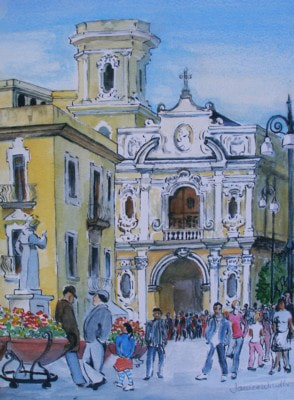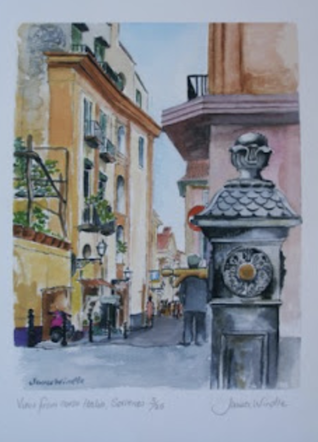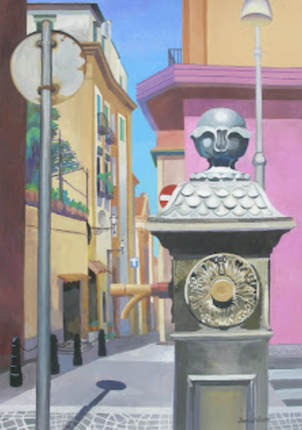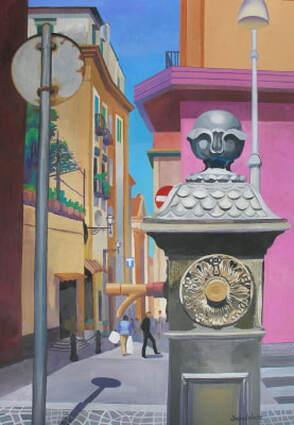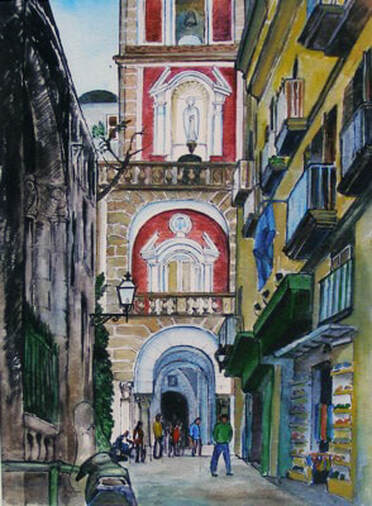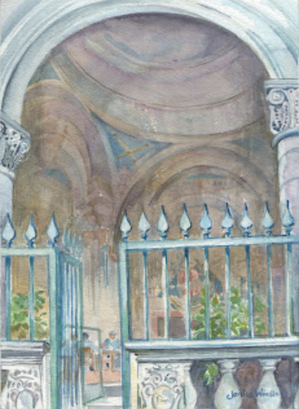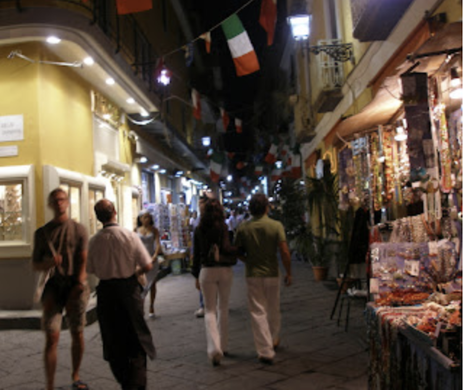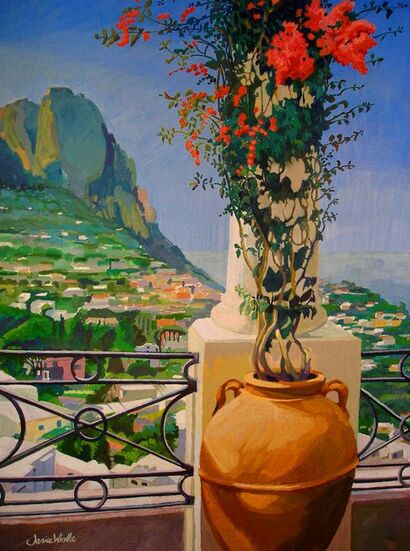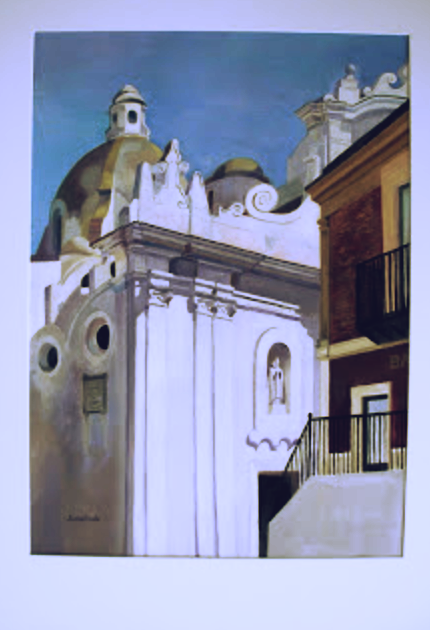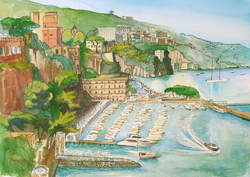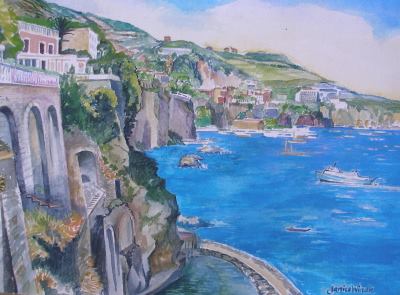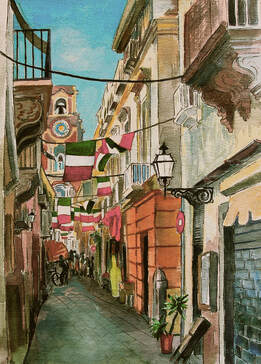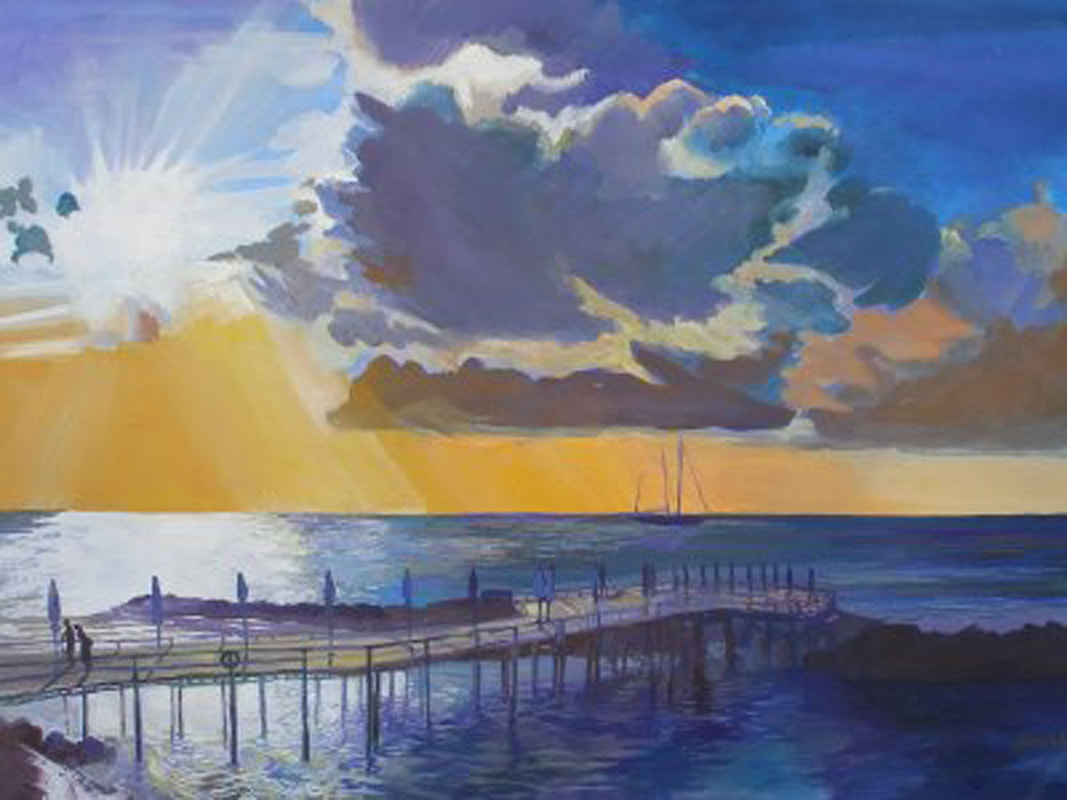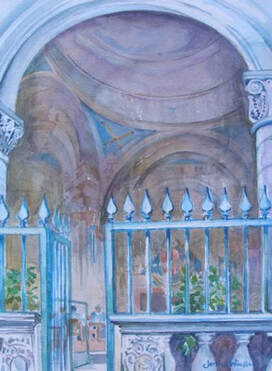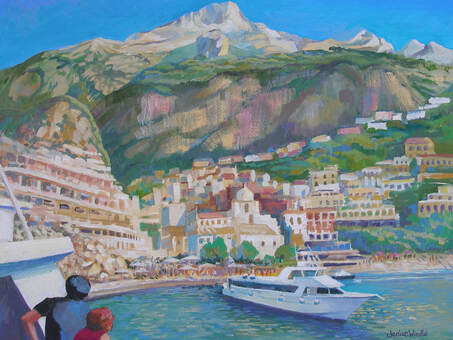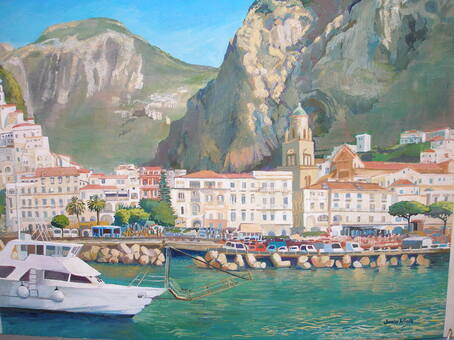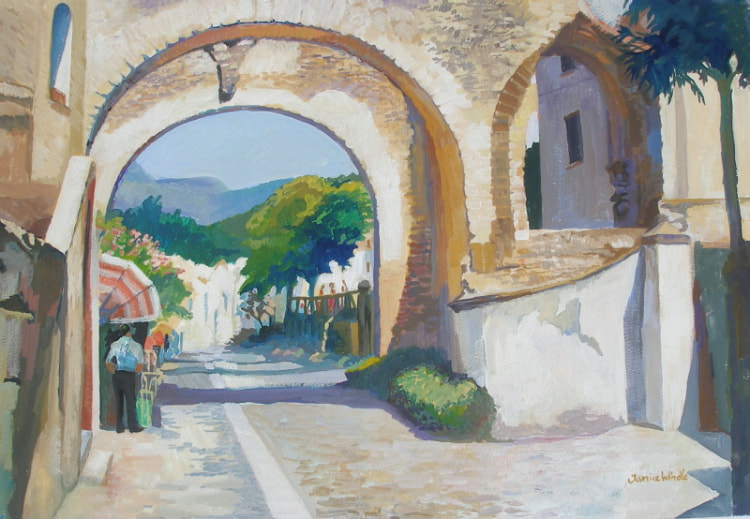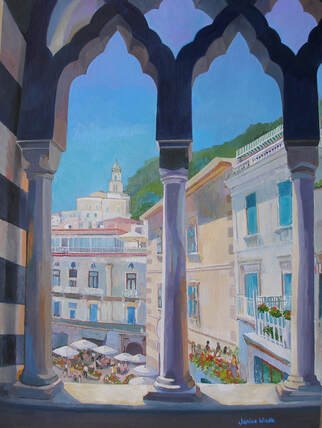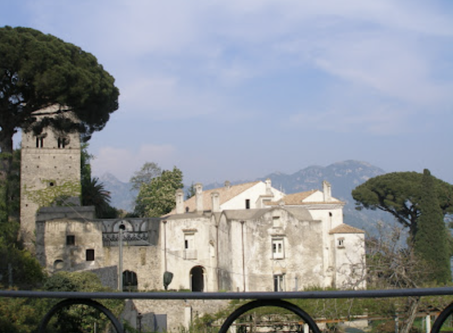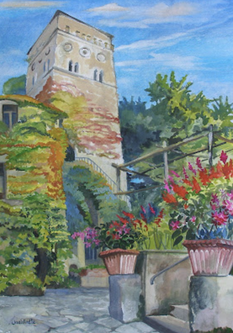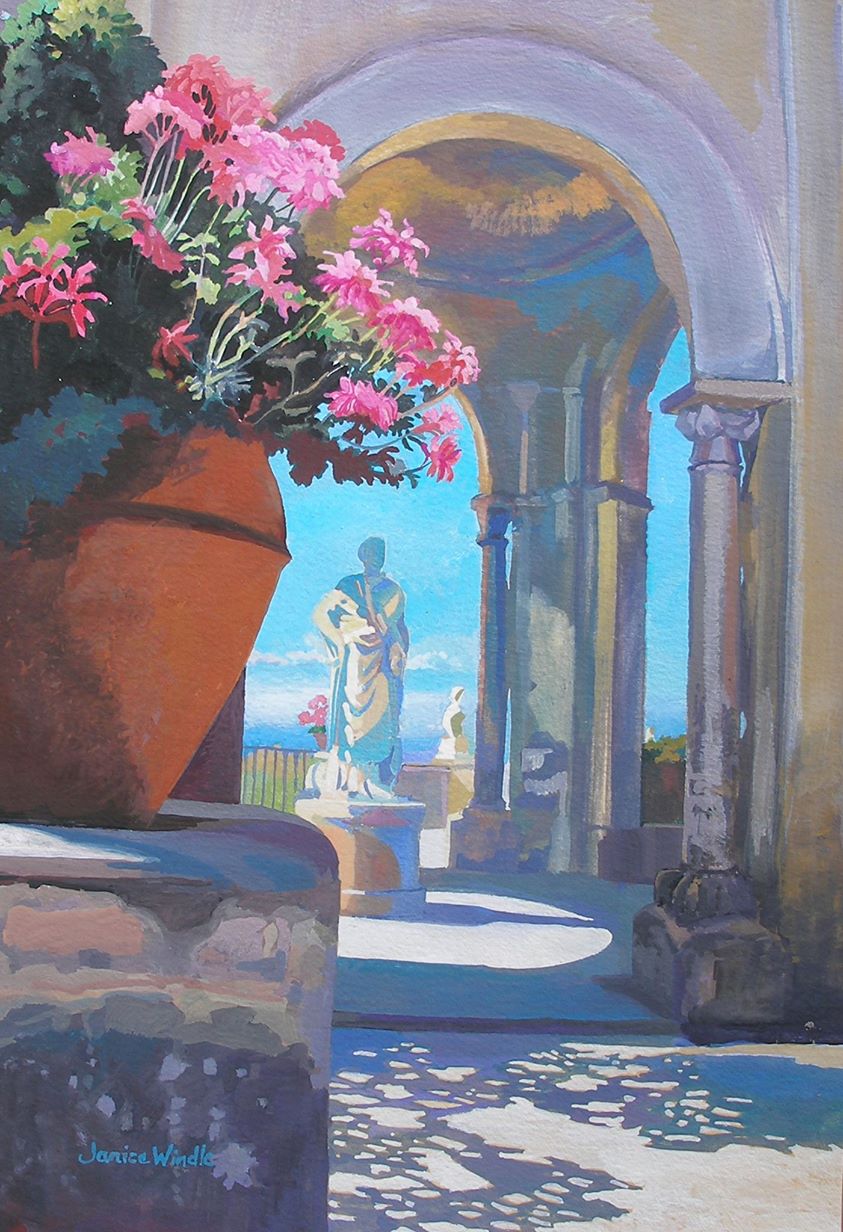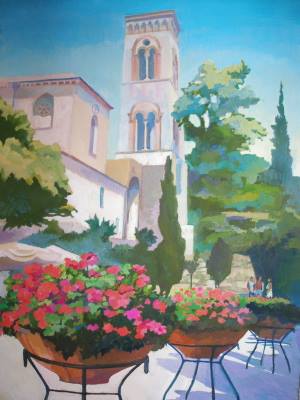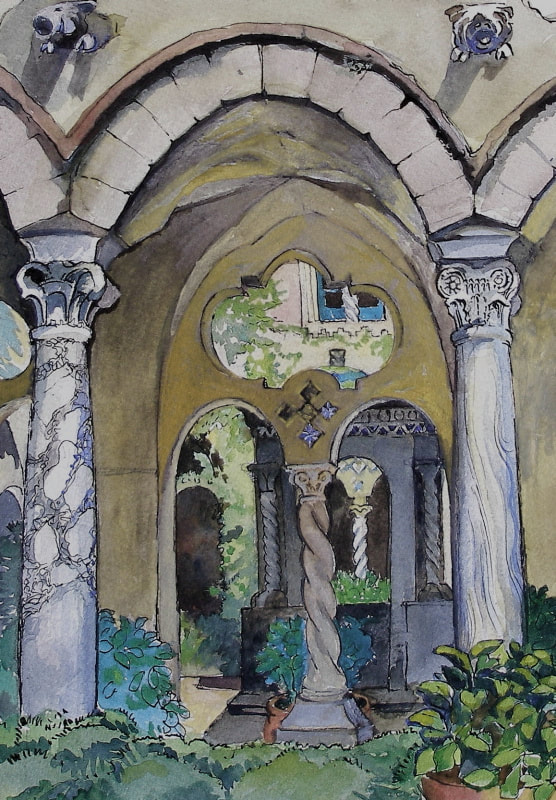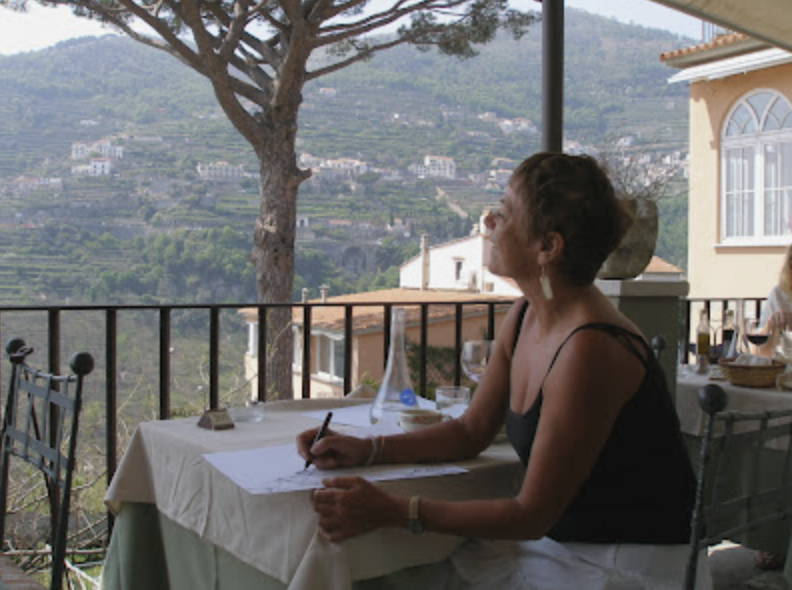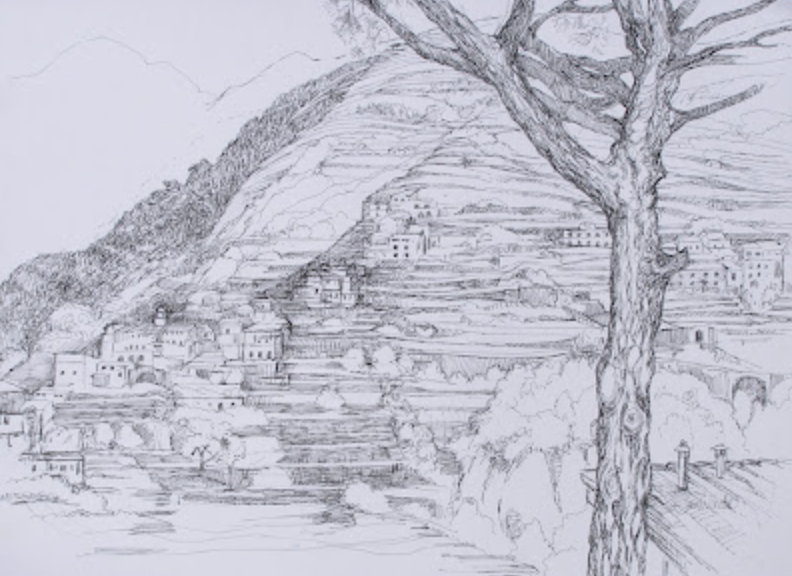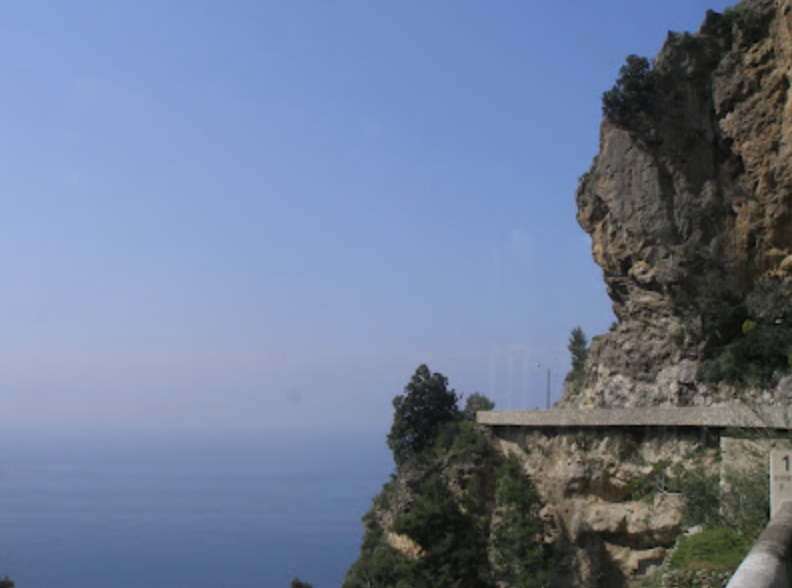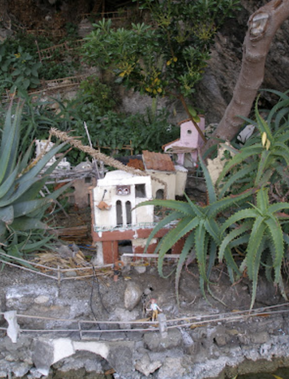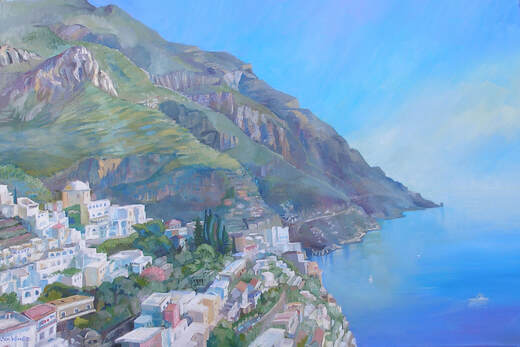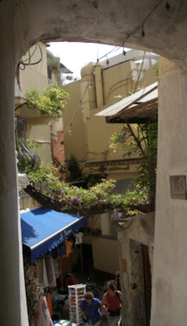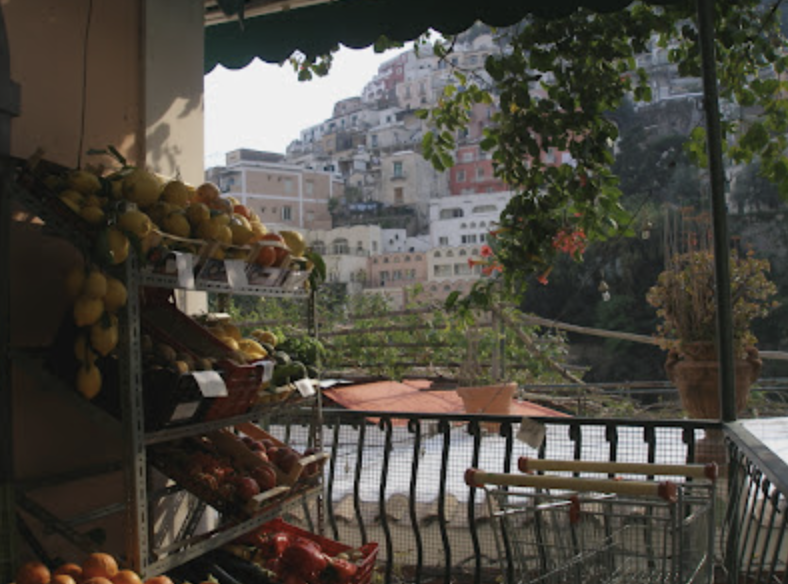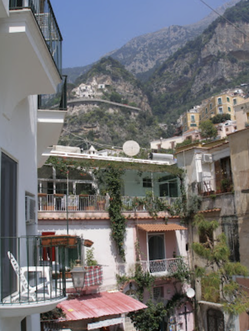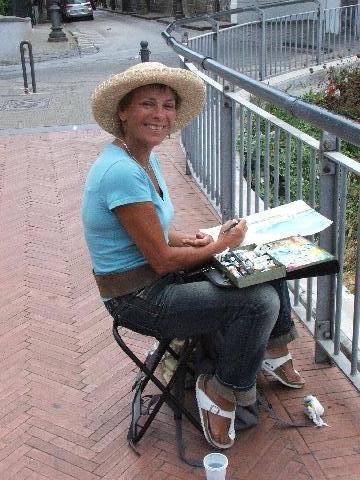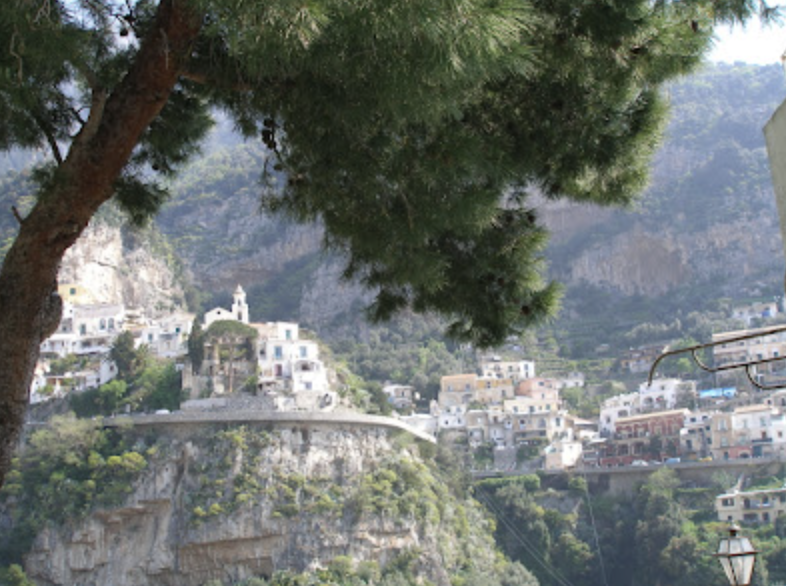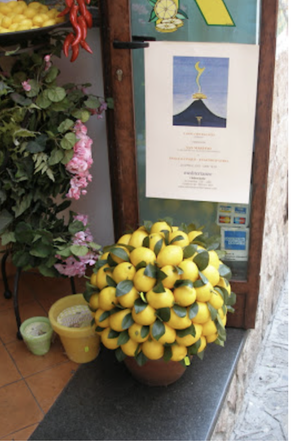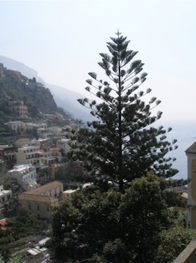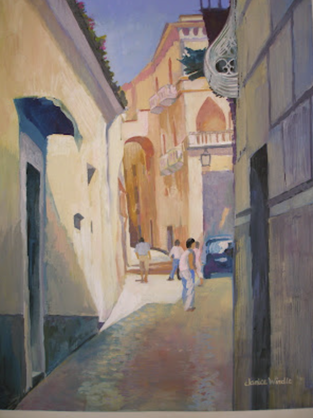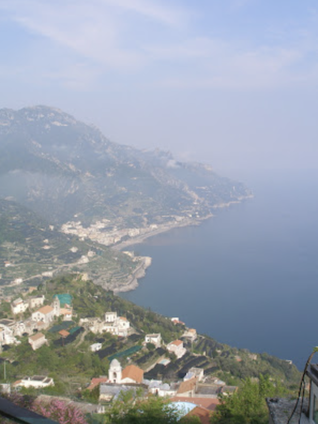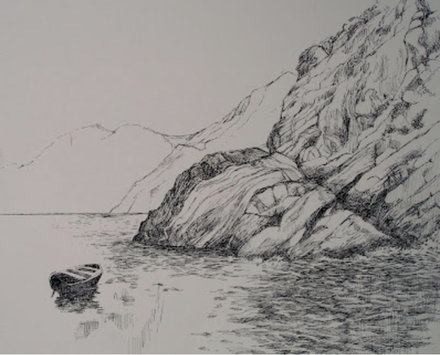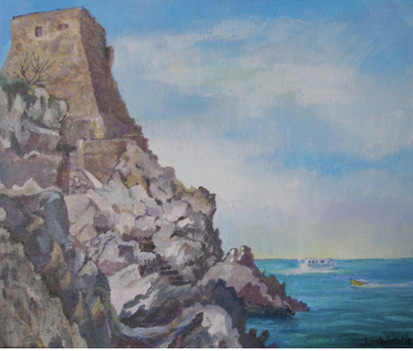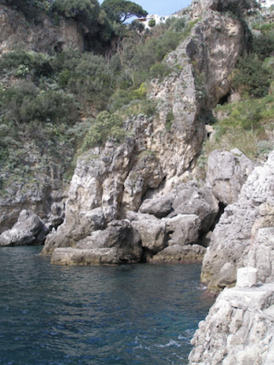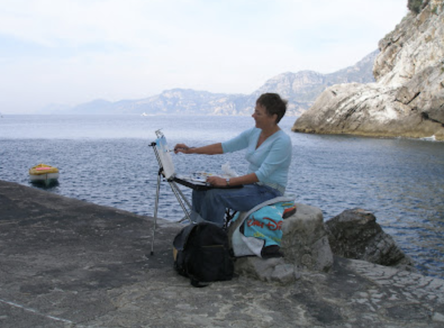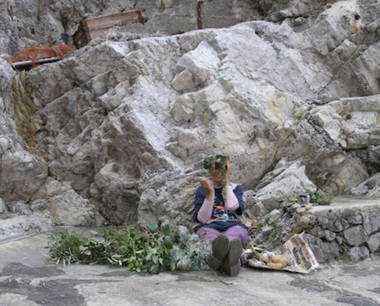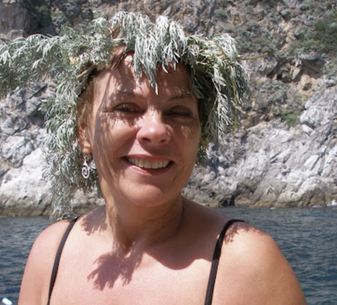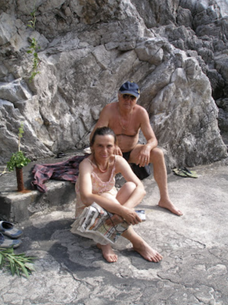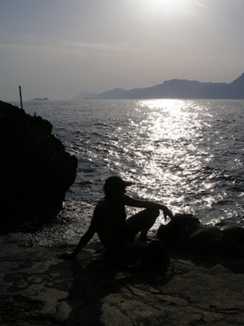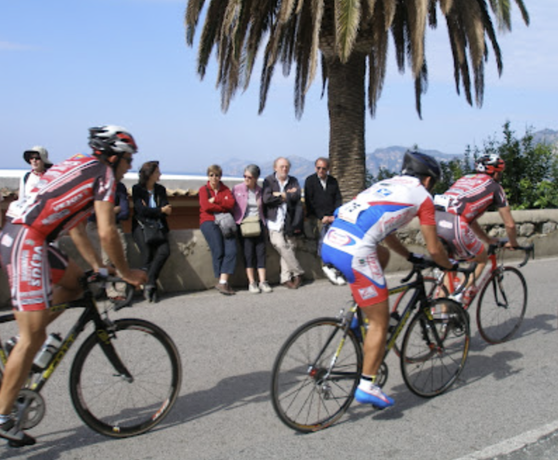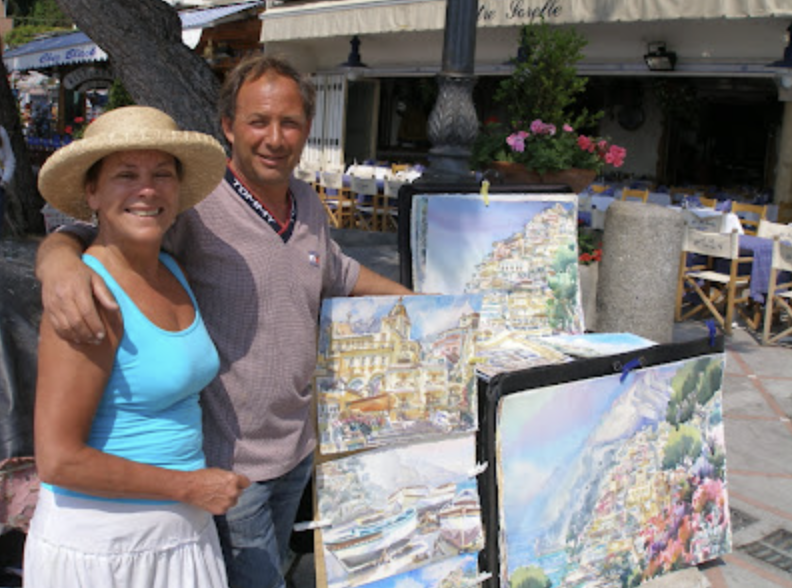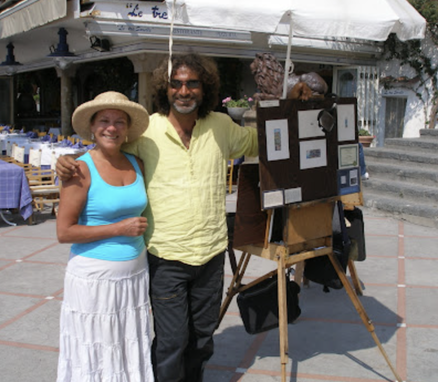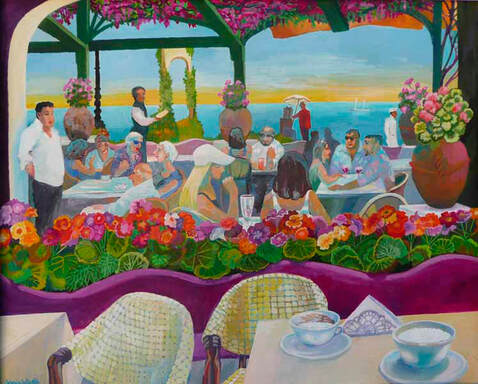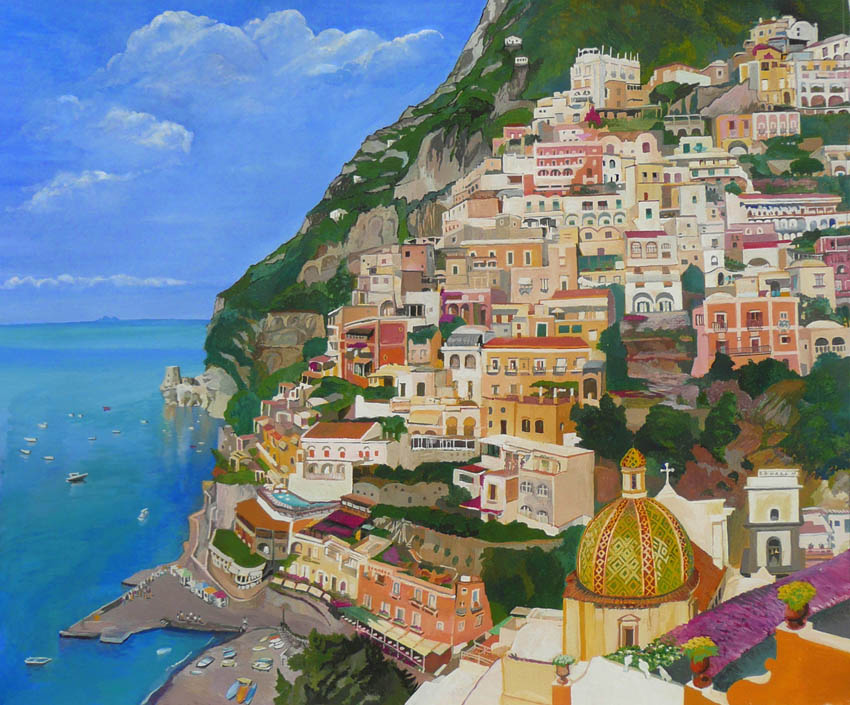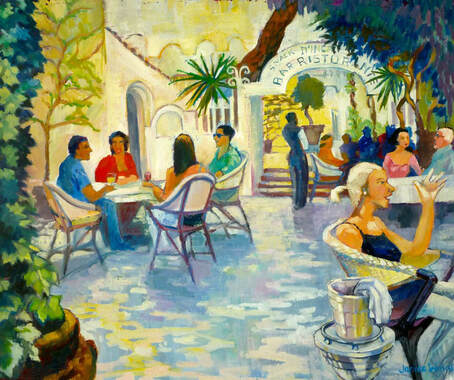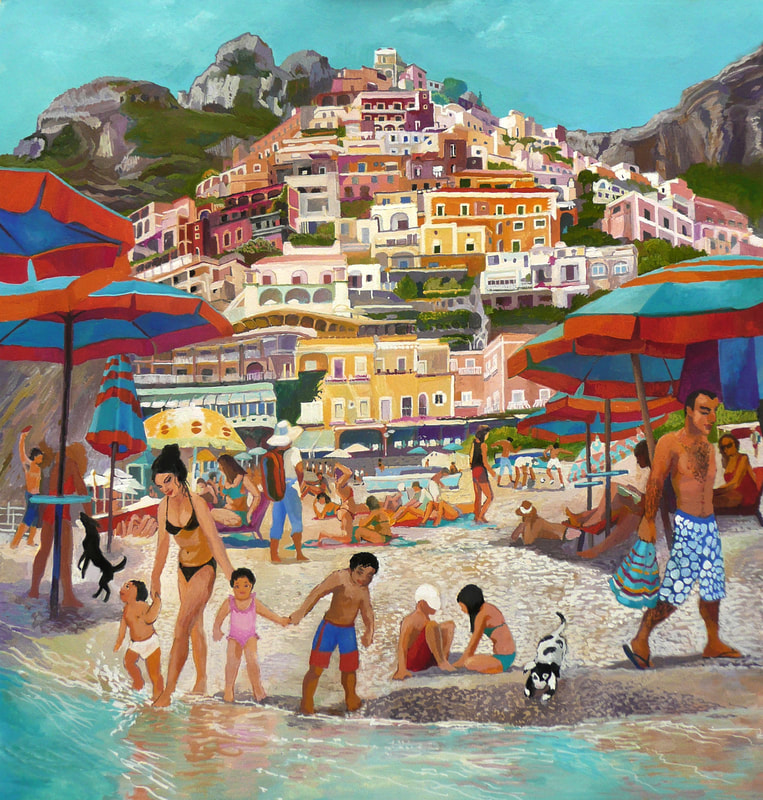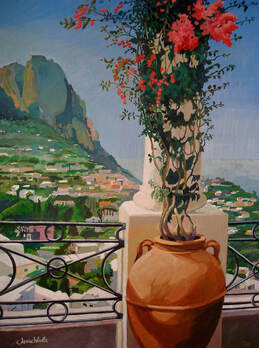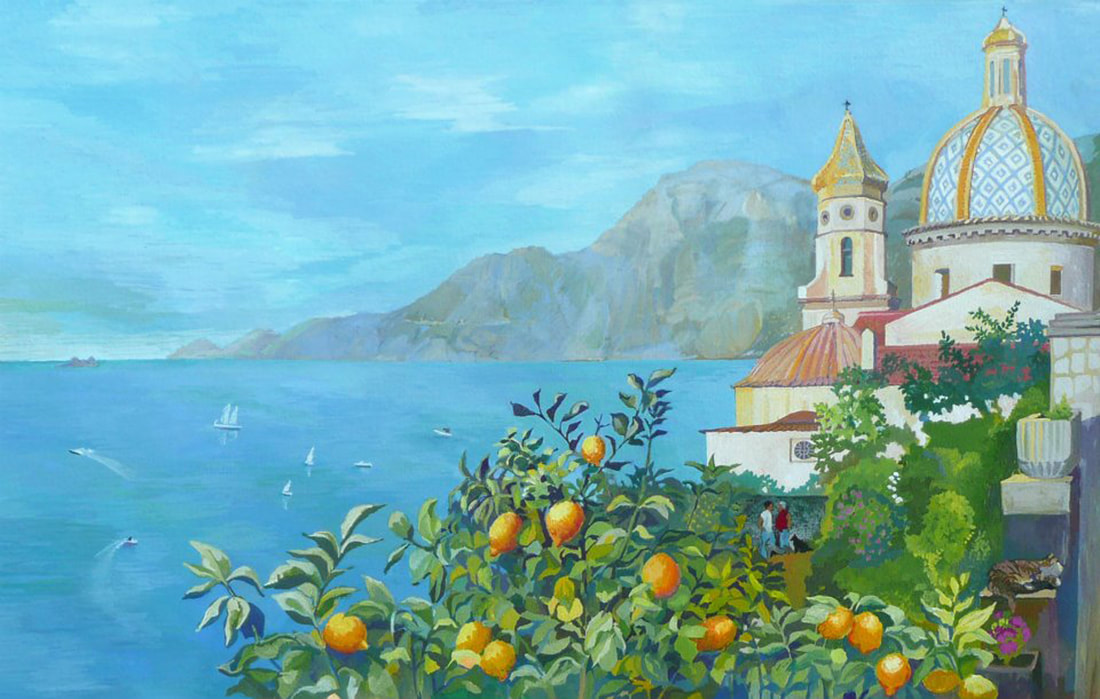It was in 2004 that I first fell in love with the Amalfi Coast in Italy, when I fell out of love with my life at home and began exploring Sorrento and its neighbouring towns. I kept a journal, but published it mostly on MySpace, on an account that I have closed. Now (2022) I want to preserve the notes that I posted fifteen years ago on a Blogspot blog, since corrupted and deleted, so that I can read and remember those times of visiting Italy as a solo traveller,
By April 2005 I had spent eighteen months preparing myself for a new mind-set through which I would be freer, more creative and more independent than at any time since I was in my twenties. I was approaching 60 fast; retirement from my teaching job was in sight and I was getting ready for the next and hopefully the most fulfilling phase of my life. The Neapolitan coast, where I had first glimpsed the possibilities before me, became an icon and an inspiration that kept me going, all through the long grey winter months.
In 2006 I decided to spread my holidays over three months and to extend my interest to Amalfi, Positano, Capri and Ischia. I had no partner and continued to travel alone. I am naturally a loner and wanted to be independent, not answerable to anyone else, but that has its down-side in a country full of such gregarious people as the Southern Italians. I decided that a week per visit would give me enough space and time to get what I wanted from the breaks, without feeling like an oddball or inviting the ready sympathy of the Italians when I dined alone...... I booked three separate return flights to Naples, in August, September and October.
By April 2005 I had spent eighteen months preparing myself for a new mind-set through which I would be freer, more creative and more independent than at any time since I was in my twenties. I was approaching 60 fast; retirement from my teaching job was in sight and I was getting ready for the next and hopefully the most fulfilling phase of my life. The Neapolitan coast, where I had first glimpsed the possibilities before me, became an icon and an inspiration that kept me going, all through the long grey winter months.
In 2006 I decided to spread my holidays over three months and to extend my interest to Amalfi, Positano, Capri and Ischia. I had no partner and continued to travel alone. I am naturally a loner and wanted to be independent, not answerable to anyone else, but that has its down-side in a country full of such gregarious people as the Southern Italians. I decided that a week per visit would give me enough space and time to get what I wanted from the breaks, without feeling like an oddball or inviting the ready sympathy of the Italians when I dined alone...... I booked three separate return flights to Naples, in August, September and October.
Sorrento April 2005
La Chiesa Dell' Carmine, Piazza Tasso, Sorrento
It was early April, the Easter holidays. The weather was bright and cool and windy as I got off the bus in the Piazza Tasso. I was greeted immediately by a smiling young Italian. He led me round the corner of the Piazza into the Via San Francesco, where I had booked an apartment. The apartment faced on to the little street where a constant procession of scooters, cars, vans and tourists passed within a few inches of the building. Alessandro showed me the apartment, right on the street side with a tiny balcony overlooking the bustle below. I would enjoy the view, said Alessandro.
Even Alessandro – a very charming and persuasive man – could not convince me that I would get a wink of sleep in this room, and so he showed me, hesitantly, the alternative, facing a silent building site. A building site? I questioned. Oh no, he said, there won’t be any noise – they’ve run out of money to go on with the work. And I believed him and settled into this Spartan – but very clean and – yes – he was right – absolutely peaceful apartment, for the next week.
I had come to draw Sorrento and I set up a working routine straight away. In the mornings, I would go out and get bread, fruit and croissants and have a walk round the centre of the town, getting my bearings and deciding where I would perch myself to draw for that day. In the afternoon I would have a rest in my quiet apartment and continue the morning’s drawing from memory. And in the evenings I went out to explore the restaurants and piazzas that were buzzing with life till midnight. Sorrento is a very safe town. I never felt ill at ease on my own there – though I was an object of pity for the gregarious Italians, I knew.
In my morning forays out I chose my subjects on visual, compositional grounds, rather than looking for the most popular tourist sights. I didn’t have any clear plans as to what I would do with my pictures at this time.
Drawing has always been something I just do, particularly when I’m in a new place. It’s to do with a feeling of wanting to own what I see. Picasso (with whom I would not have the nerve to compare myself in any other way) seems to have had a similar feeling about the power of the artist’s gaze. I have been rereading parts of John Richardson’s vast biography of him and find this: discussing two watercolours of Picasso’s intended lover Fernande asleep, showing her watched by two different men. Richardson writes that he believes that Picasso painted these in an attempt to persuade Fernande to become his lover rather than stay with the sculptor Debienne: Picasso’s eyes seem to exert a strange power: the mirada fuerte power to conjure Fernande from the bed of the weak watcher into the arms of the strong watcher. (“A Life of Picasso Volume 1 1886-1906” published by Jonathan Cape (1991) - page 317)
I had no such erotic motivation but I wanted to express my delight in being there in that week, in that cool bright windy Mediterranean town, by capturing the sights in front of me. So having decided on my location for the day’s work, I would settle down on my folding stool and begin.
First a detailed pencil drawing using only line – I was working on a pad of watercolour paper just a little bigger than A4. This would take anything up to an hour and a half.
Next, I took waterproof ink and a mapping pen with a flexible nib and drew over the pencil, changing it, emphasising the important details and structures and suppressing the superfluous details. I added people who passed by, if they caught my eye and imagination. I built the picture gradually. Then I erased the pencil marks.
Now I could go into colour. With watercolour I touched in washes of yellows greys, ochres, gingery reds, blue and mauve reflecting from the sky into the shadows – for almost the first time I appreciated why that creamy yellow is called Naples yellow, and the difference between that and the harsher earthy colour of yellow ochre. Venetian red and umber – all those so-Italian names, in thin washes. The white paper ricochets the light back through the layers and the colour glows luminously. Final touches were made with the pen and a very small brush – size 00
The small painting at the beginning of this article was the first outdoor painting that I made, that cool April week. I was sitting outside the Bar Fauno, the big café-restaurant that dominates the Piazza Tasso. The 17th Century Chiesa delle Carmine, the baroque church on the corner, caught my eye with its flamboyant decorations and peeling Naples yellow stucco. Inside, it is used as an art gallery.
There is a constant flow across the wide piazza, of people of all ages and many nationalities (in August many of them British, at Easter and in October many Americans, as well as Germans, Dutch, Australian, French, Scandinavian, East European and of course Italian tourists.) It’s a popular place in the evenings and the Chiesa delle Carmine looks splendid in its floodlighting.
That first morning in Sorrento solo, my pen traced the arabesques of the carvings and the mobile, voluble figures of the Italians and tourists meeting and chatting in the piazza, and I was absolutely happy.
In the centre of the swirling traffic is a statue of a pope or saint whose name I forget. I think it is Saint Anthony – he has the crook and mitre that show he is a figure of high standing in the church. The square is named after Torquato Tasso (1544-595), the famous poet who was born and lived in Sorrento and whose house you can find in one of the quiet back streets leading down to the Marina Grande. I found it very difficult to photograph the statue in the centre of the Piazza Tasso because you risked life and limb to cross the road nearby, let alone stopping to take a photo.
I am always struck by the lovely lines of the wrought iron street lamps in Italy. I do attract some funny looks from Italians, particularly when I go round the streets with my neck craning upwards at the lamps and the carving, too, over doorways and windows and on balconies.
I found my next subject by walking along the Via degli Aranci and through the ruined Roman city gate arch that leads back to the Corsa Italia which is the main shopping street in Sorrento. On the pavement outside the Duomo, I found a water-fountain made of bronze, still used by passers-by and by the occasional dog who licked up the drips from the stone work around it. I'm told that this fountain may not be very ancient but it had a character that made me stop and look, set up my stool and draw it.
Even Alessandro – a very charming and persuasive man – could not convince me that I would get a wink of sleep in this room, and so he showed me, hesitantly, the alternative, facing a silent building site. A building site? I questioned. Oh no, he said, there won’t be any noise – they’ve run out of money to go on with the work. And I believed him and settled into this Spartan – but very clean and – yes – he was right – absolutely peaceful apartment, for the next week.
I had come to draw Sorrento and I set up a working routine straight away. In the mornings, I would go out and get bread, fruit and croissants and have a walk round the centre of the town, getting my bearings and deciding where I would perch myself to draw for that day. In the afternoon I would have a rest in my quiet apartment and continue the morning’s drawing from memory. And in the evenings I went out to explore the restaurants and piazzas that were buzzing with life till midnight. Sorrento is a very safe town. I never felt ill at ease on my own there – though I was an object of pity for the gregarious Italians, I knew.
In my morning forays out I chose my subjects on visual, compositional grounds, rather than looking for the most popular tourist sights. I didn’t have any clear plans as to what I would do with my pictures at this time.
Drawing has always been something I just do, particularly when I’m in a new place. It’s to do with a feeling of wanting to own what I see. Picasso (with whom I would not have the nerve to compare myself in any other way) seems to have had a similar feeling about the power of the artist’s gaze. I have been rereading parts of John Richardson’s vast biography of him and find this: discussing two watercolours of Picasso’s intended lover Fernande asleep, showing her watched by two different men. Richardson writes that he believes that Picasso painted these in an attempt to persuade Fernande to become his lover rather than stay with the sculptor Debienne: Picasso’s eyes seem to exert a strange power: the mirada fuerte power to conjure Fernande from the bed of the weak watcher into the arms of the strong watcher. (“A Life of Picasso Volume 1 1886-1906” published by Jonathan Cape (1991) - page 317)
I had no such erotic motivation but I wanted to express my delight in being there in that week, in that cool bright windy Mediterranean town, by capturing the sights in front of me. So having decided on my location for the day’s work, I would settle down on my folding stool and begin.
First a detailed pencil drawing using only line – I was working on a pad of watercolour paper just a little bigger than A4. This would take anything up to an hour and a half.
Next, I took waterproof ink and a mapping pen with a flexible nib and drew over the pencil, changing it, emphasising the important details and structures and suppressing the superfluous details. I added people who passed by, if they caught my eye and imagination. I built the picture gradually. Then I erased the pencil marks.
Now I could go into colour. With watercolour I touched in washes of yellows greys, ochres, gingery reds, blue and mauve reflecting from the sky into the shadows – for almost the first time I appreciated why that creamy yellow is called Naples yellow, and the difference between that and the harsher earthy colour of yellow ochre. Venetian red and umber – all those so-Italian names, in thin washes. The white paper ricochets the light back through the layers and the colour glows luminously. Final touches were made with the pen and a very small brush – size 00
The small painting at the beginning of this article was the first outdoor painting that I made, that cool April week. I was sitting outside the Bar Fauno, the big café-restaurant that dominates the Piazza Tasso. The 17th Century Chiesa delle Carmine, the baroque church on the corner, caught my eye with its flamboyant decorations and peeling Naples yellow stucco. Inside, it is used as an art gallery.
There is a constant flow across the wide piazza, of people of all ages and many nationalities (in August many of them British, at Easter and in October many Americans, as well as Germans, Dutch, Australian, French, Scandinavian, East European and of course Italian tourists.) It’s a popular place in the evenings and the Chiesa delle Carmine looks splendid in its floodlighting.
That first morning in Sorrento solo, my pen traced the arabesques of the carvings and the mobile, voluble figures of the Italians and tourists meeting and chatting in the piazza, and I was absolutely happy.
In the centre of the swirling traffic is a statue of a pope or saint whose name I forget. I think it is Saint Anthony – he has the crook and mitre that show he is a figure of high standing in the church. The square is named after Torquato Tasso (1544-595), the famous poet who was born and lived in Sorrento and whose house you can find in one of the quiet back streets leading down to the Marina Grande. I found it very difficult to photograph the statue in the centre of the Piazza Tasso because you risked life and limb to cross the road nearby, let alone stopping to take a photo.
I am always struck by the lovely lines of the wrought iron street lamps in Italy. I do attract some funny looks from Italians, particularly when I go round the streets with my neck craning upwards at the lamps and the carving, too, over doorways and windows and on balconies.
I found my next subject by walking along the Via degli Aranci and through the ruined Roman city gate arch that leads back to the Corsa Italia which is the main shopping street in Sorrento. On the pavement outside the Duomo, I found a water-fountain made of bronze, still used by passers-by and by the occasional dog who licked up the drips from the stone work around it. I'm told that this fountain may not be very ancient but it had a character that made me stop and look, set up my stool and draw it.
|
Large gouache painting finished 2007: final
'Drinking Fountain, Sorrento' |
It was a bright fresh April day in Sorrento when I painted the little watercolour sketch of the drinking fountain. It was cool but I was wearing sunglasses when I began the drawing. As always when drawing outside I found myself periodically surrounded by admiring children.
Italian children are among the most polite and charming in the world, I have found. With my smattering of Italian I was engaged in conversation by a group whose comments to each other and me of “Bello! Bellissimo!” were apparently heartfelt. They tried to ask me questions but gave up, all except for one little boy of about 8, who not only managed to make me understand that he wanted to know what I intended to do with my picture when it was finished, but went off and got his father to look at it.
Tactfully, his father assured his son that I would have no intention of selling the work. It was only later that I realised that he was protecting me from making statements that might get me into trouble with the police. Art sales in Italy are heavily taxed and you are not allowed to sell in the street. But, as another artist, in Positano, assured me later, no-one can stop you painting in the street.
It was while I was painting there outside the Duomo that I had my first and so far only experience of bad behaviour in Sorrento. Having put my sunglasses down next to me when I began applying colour to the picture, I was suddenly surrounded by teenagers – apparently interested in my picture – but when they had gone my sunglasses went with them! That was a lesson I needed to learn.
My next stake-out was at the Mona Lisa restaurant in the old part of Sorrento. This café is right opposite the Sedile Dominova, a Roman building that is still a meeting place for Sorrentinos to read their newspapers and chat. A friend who was born and brought up in Sorrento told me that it was originally a meeting place for Roman women to meet, and the name refers to that, in Latin – the ladies’ sitting place.
On this first occasion I was not looking at Sedile Dominova, but at the campanile of the Duomo, up the street next to it. This year (2005)the tower has been undergoing repairs but when I painted the picture below it was a lovely sight. Classically proportioned tiers of brick, rusticated stone, marble and plaster arches frame a graceful Madonna, the bells and at the very top a beautiful blue and gold faced clock.
Italian children are among the most polite and charming in the world, I have found. With my smattering of Italian I was engaged in conversation by a group whose comments to each other and me of “Bello! Bellissimo!” were apparently heartfelt. They tried to ask me questions but gave up, all except for one little boy of about 8, who not only managed to make me understand that he wanted to know what I intended to do with my picture when it was finished, but went off and got his father to look at it.
Tactfully, his father assured his son that I would have no intention of selling the work. It was only later that I realised that he was protecting me from making statements that might get me into trouble with the police. Art sales in Italy are heavily taxed and you are not allowed to sell in the street. But, as another artist, in Positano, assured me later, no-one can stop you painting in the street.
It was while I was painting there outside the Duomo that I had my first and so far only experience of bad behaviour in Sorrento. Having put my sunglasses down next to me when I began applying colour to the picture, I was suddenly surrounded by teenagers – apparently interested in my picture – but when they had gone my sunglasses went with them! That was a lesson I needed to learn.
My next stake-out was at the Mona Lisa restaurant in the old part of Sorrento. This café is right opposite the Sedile Dominova, a Roman building that is still a meeting place for Sorrentinos to read their newspapers and chat. A friend who was born and brought up in Sorrento told me that it was originally a meeting place for Roman women to meet, and the name refers to that, in Latin – the ladies’ sitting place.
On this first occasion I was not looking at Sedile Dominova, but at the campanile of the Duomo, up the street next to it. This year (2005)the tower has been undergoing repairs but when I painted the picture below it was a lovely sight. Classically proportioned tiers of brick, rusticated stone, marble and plaster arches frame a graceful Madonna, the bells and at the very top a beautiful blue and gold faced clock.
|
The waitresses at the Mona Lisa were very surprised by my activities with pen and watercolour but very patient and flatteringly interested in my drawing. The little paintings took me two mornings to complete, so I drank rather a lot of coffee and ate lots of the delicious petits fours that they served with it – not cheap mornings but very pleasant. When I went back, in the summer, the same waiters were there and I was able to continue exploring in watercolour and ink this extremely old (though now very commercialised) crossroads in the “Historic Centre” part of Sorrento.
|
Here is my watercolour of the Sedile Dominova, looking directly in at the trompe l’oeuil paintings inside the apse-shaped hall. This one took me many hours of patient drawing before I began building up the layers of colour to show that patina that covered the aged stone pillars. Painting a painting is never easy either – some of the mouldings inside are solid and others are painted illusions by 17th century artists.
This painting was used by Givanni Petagna in his book about historic Sorrento, Sorrento: Il Conservatorio di Santa Maria delle Grazie which was published in 2006. This is an erudite history (in Italian) of the Conservatorio, in the Piazza S Francesco, a few yards from where I stayed on that first solo visit to Sorrento.
I visited Pompeii during that first week, too. My tonal drawing of one of the tall arches at the end of the Forum took me all day. It was a little laboured and reminds me of those 19th century illustrations to travel books. Apart from a surreal conversation with a large American surrounded by nervous Italian bodyguards who told me that I ought to recognise him – he was a world famous wrestler and he certainly looked it (his hair was dyed gold and he was dressed mainly in gold lame) this was not a memorable visit to what is a truly fascinating place. I have promised myself that I shall do Pompeii justice one day, but Sorrento had my heart that week in April 2005.
This painting was used by Givanni Petagna in his book about historic Sorrento, Sorrento: Il Conservatorio di Santa Maria delle Grazie which was published in 2006. This is an erudite history (in Italian) of the Conservatorio, in the Piazza S Francesco, a few yards from where I stayed on that first solo visit to Sorrento.
I visited Pompeii during that first week, too. My tonal drawing of one of the tall arches at the end of the Forum took me all day. It was a little laboured and reminds me of those 19th century illustrations to travel books. Apart from a surreal conversation with a large American surrounded by nervous Italian bodyguards who told me that I ought to recognise him – he was a world famous wrestler and he certainly looked it (his hair was dyed gold and he was dressed mainly in gold lame) this was not a memorable visit to what is a truly fascinating place. I have promised myself that I shall do Pompeii justice one day, but Sorrento had my heart that week in April 2005.
.....................................................
Sorrento, Summer 2005
After my first solo visit to Sorrento, in a cool week in April 2005, I began to book cheap flights to Naples, always through British Airways, whenever the grey life of England seemed to be closing in on me. I always knew that I had that eticket tucked away, like a forbidden bar of chocolate, in a drawer, ready to whisk me off to the Mediterrranean. Though perhaps "whisk" is not quite the word - I always travel on that morning flight for which you have to be at the airport at 5am or so, even earlier now....
My summer visit in 2005 was for 23 days - and I really learned my way around in that time. The buses, trains and boats took me up and down the coast with my sketch book and camera, always returning to Sorrento in the evenings to go to my favourite restaurant that year, a place called "L'Osteria del Buon'Aventuro" This old building off the Piazza San Fancesco housed a ristorante in which the manager, Nello, was flanked by two other middle aged Neapolitans, Renato and Antonio, who provided the live entertainment for tourists and others several nights of the week.
I first wandered in there one evening in August when every other place was full or booked. I was welcomed enthusiastically because l'Osteria is off the main thoroughfare, up a side alley, and gets little passing trade. Nello, as the English speaker who had worked in London for some time in the '80s, was the barker who stood outside ushering potential clients down into the wood panelled stone vaulted cellar which housed the restaurant. I normally resist this kind of invitation but I was very hungry that first evening.
I decided to eat at one of the tables that stood outside, however, because it looked hot and crowded downstairs. There on that first evening I met a charming Irish couple who became the first buyers of my Sorrento pictures. They opted to buy two of the originals, rather than the cheaper prints, and I was pleased to sell to such an appreciative couple - they told me exactly where they would site the framed pictures in their house.
My summer visit in 2005 was for 23 days - and I really learned my way around in that time. The buses, trains and boats took me up and down the coast with my sketch book and camera, always returning to Sorrento in the evenings to go to my favourite restaurant that year, a place called "L'Osteria del Buon'Aventuro" This old building off the Piazza San Fancesco housed a ristorante in which the manager, Nello, was flanked by two other middle aged Neapolitans, Renato and Antonio, who provided the live entertainment for tourists and others several nights of the week.
I first wandered in there one evening in August when every other place was full or booked. I was welcomed enthusiastically because l'Osteria is off the main thoroughfare, up a side alley, and gets little passing trade. Nello, as the English speaker who had worked in London for some time in the '80s, was the barker who stood outside ushering potential clients down into the wood panelled stone vaulted cellar which housed the restaurant. I normally resist this kind of invitation but I was very hungry that first evening.
I decided to eat at one of the tables that stood outside, however, because it looked hot and crowded downstairs. There on that first evening I met a charming Irish couple who became the first buyers of my Sorrento pictures. They opted to buy two of the originals, rather than the cheaper prints, and I was pleased to sell to such an appreciative couple - they told me exactly where they would site the framed pictures in their house.
In the hot dusty evenings of Sorrento in August I would sit at my table on the pavement outside L'Osteria and order the specialities of the house: heaped plates of mussels - they did the best steamed mussels in Sorrento; tomato salads scattered with aromatic basil leaves; prawns; grilled courgettes and aubergines and fresh sardines. The view was not conventionally romantic but it was very Southern Italian - a peeling stuccoed wall with an arched gate through which you could just see some orange trees, and a row of scooters.
At about ten o'clock in the evening there would be a rasping, clattering sound and Antonio would drive his battered car into the alley and park it, swiftly, accurately and with a flourish, in a space next to the wall which allowed about 3 centimetres' leeway. He would loop a chain around it for some reason - perhaps it didn't have a lock.
Usually Renato would already be in the resturant downstairs, performing for the clients. Renato was a guitarist and a good one. He played old and new Neapolitan songs, Sinatra and Dean Martin favourites, Beatles songs, and was the typical "You hum it and I'll play along with it" kind of musician. It was something of a relief when Antonio arrived, however, because Renato was no singer and Antonio had a magnificent tenor voice that drowned Renato out altogether.
As August wore on, I ventured downstairs and began having my solitary dinner at one of the gold brocade covered tables facing the entrance to the cellar from the street. This table became "mine" and I was treated as a regular, which I had become. Nello's beautiful sixteen year old daughter would serve me and ask what I had drawn that day, because I always had my sketch book with me. One evening I drew a portrait of her as she dashed about serving and calling orders in her husky smoker's voice (I had seen her with her taking cigarette breaks when I sat outside). I gave it to her and then I had to do a picture of Renato as well, who swore undying love if I would do so.
I finally brought my paints in on a quiet night and painted a scene of the interior, with Renato and Antonio playing and singing, Nadia the Croatian girl who ran the till and Nello's daughter in the background. In the foreground, of course, the gold brocade table cloth and my glass of red wine. I gave it to Nello and I don't know what happened to it later.
[When I went back to the Osteria the following summer, it was under new management. The plates of mussels were much smaller and there were some among them that had failed to open (a dangerous sign, as all mussel aficionados know). Renato was nowhere to be seen and no one knew where he had gone to, though Antonio turned up as usual and promised to put Nello in touch with me. To my surprise, he did, and a day or two later Nello bought me dinner at another resturant in which he had friends. He hinted at a story of betrayal and disappointment, with many shrugs and sideways looks, which apparently explained why he no longer ran l'Osteria dell'Bouon'Aventura.]
I am sorry that I can't here include a drawing from my time as a regular at the Osteria, but I gave all of them to the people who formed their subjects. After their first surprise that I stayed so long in Sorrento on my own, they welcomed me and included me in their sessions of music and song, as far as my limited Italian and their limited English would allow. I can list among the most embarrassing moments of my entire life my rendition of "Yesterday" to the crowded restaurant, one Wednesday evening.
At about ten o'clock in the evening there would be a rasping, clattering sound and Antonio would drive his battered car into the alley and park it, swiftly, accurately and with a flourish, in a space next to the wall which allowed about 3 centimetres' leeway. He would loop a chain around it for some reason - perhaps it didn't have a lock.
Usually Renato would already be in the resturant downstairs, performing for the clients. Renato was a guitarist and a good one. He played old and new Neapolitan songs, Sinatra and Dean Martin favourites, Beatles songs, and was the typical "You hum it and I'll play along with it" kind of musician. It was something of a relief when Antonio arrived, however, because Renato was no singer and Antonio had a magnificent tenor voice that drowned Renato out altogether.
As August wore on, I ventured downstairs and began having my solitary dinner at one of the gold brocade covered tables facing the entrance to the cellar from the street. This table became "mine" and I was treated as a regular, which I had become. Nello's beautiful sixteen year old daughter would serve me and ask what I had drawn that day, because I always had my sketch book with me. One evening I drew a portrait of her as she dashed about serving and calling orders in her husky smoker's voice (I had seen her with her taking cigarette breaks when I sat outside). I gave it to her and then I had to do a picture of Renato as well, who swore undying love if I would do so.
I finally brought my paints in on a quiet night and painted a scene of the interior, with Renato and Antonio playing and singing, Nadia the Croatian girl who ran the till and Nello's daughter in the background. In the foreground, of course, the gold brocade table cloth and my glass of red wine. I gave it to Nello and I don't know what happened to it later.
[When I went back to the Osteria the following summer, it was under new management. The plates of mussels were much smaller and there were some among them that had failed to open (a dangerous sign, as all mussel aficionados know). Renato was nowhere to be seen and no one knew where he had gone to, though Antonio turned up as usual and promised to put Nello in touch with me. To my surprise, he did, and a day or two later Nello bought me dinner at another resturant in which he had friends. He hinted at a story of betrayal and disappointment, with many shrugs and sideways looks, which apparently explained why he no longer ran l'Osteria dell'Bouon'Aventura.]
I am sorry that I can't here include a drawing from my time as a regular at the Osteria, but I gave all of them to the people who formed their subjects. After their first surprise that I stayed so long in Sorrento on my own, they welcomed me and included me in their sessions of music and song, as far as my limited Italian and their limited English would allow. I can list among the most embarrassing moments of my entire life my rendition of "Yesterday" to the crowded restaurant, one Wednesday evening.
..............................................
Summer 2006
'Bougainvillea, Capri'
It was in August 2006 that I first went on the ferry to Capri from Sorrento. The atmosphere was hot, dusty, unreasonably crowded and anything but picturesque when I arrived at the top of the funicular railway that runs up from the port to Capri town. I was not in a very forgiving mood, either, because I had had to point out to the boy in the biglietteria for the funicular that I had given him a twenty euro note, not one for ten. This was the first time that I had been treated like that in this area and I felt let down. I wondered how many other times it had happened without my noticing - but I preferred to believe that it was a symptom of the frenetic commercialisation that permeated the atmosphere of Capri.
Capri is naturally beautiful, a large island with a plateau at its centre and great sweeping cliffs rising from the shores. I have only been there for one afternoon in three summers, so little did I enjoy trailing around with a thousand other foreigners among the fashionable shops in Capri town. It was difficult to find the path to the Villa Jovis on the cliff overlooking Capri town and by the time I started up the steep track it was late in the afternoon. I couldn't face the climb and settled for a photograph across to the cliff from the terrace outside the funicular. 'Bougainvillea, Capri' is the gouache painting that I made when I went back to England, from the photographs I took that day. The flowers and the lovely earthenware pot they are growing in was the main inspiration for the composition. It's one of a series of ten paintings I completed in gouache, all about 50cm along their longest side. The villa was built by the Roman Emperor Nero and is in a fine defensive position. The path is steep and winding and I've promised myself that I shall go there in a cool season and climb up to admire the view, but I have been sidetracked each year by my explorations of the mainland coast towns. [I visited it finally with my partner Dónall in 2008]
Capri is naturally beautiful, a large island with a plateau at its centre and great sweeping cliffs rising from the shores. I have only been there for one afternoon in three summers, so little did I enjoy trailing around with a thousand other foreigners among the fashionable shops in Capri town. It was difficult to find the path to the Villa Jovis on the cliff overlooking Capri town and by the time I started up the steep track it was late in the afternoon. I couldn't face the climb and settled for a photograph across to the cliff from the terrace outside the funicular. 'Bougainvillea, Capri' is the gouache painting that I made when I went back to England, from the photographs I took that day. The flowers and the lovely earthenware pot they are growing in was the main inspiration for the composition. It's one of a series of ten paintings I completed in gouache, all about 50cm along their longest side. The villa was built by the Roman Emperor Nero and is in a fine defensive position. The path is steep and winding and I've promised myself that I shall go there in a cool season and climb up to admire the view, but I have been sidetracked each year by my explorations of the mainland coast towns. [I visited it finally with my partner Dónall in 2008]
The Old Duomo, Capri Town (back view)
This painting, also completed in the winter of 2005 to 2006, was inspired by a photo that I took from the side of St Stefano's Cathedral in Capri. I've called it variously "Baroque v Classical" and "S. Stefano and the Bank of Italy". I love the baroque facades of Italian churches and here the religious building and the secular one balance each other. I've avoided including people in these paintings: on Capri there were too many people and I preferred to point my gaze upwards at nature and the architecture. [In 2007 I sold this painting to someone in Guildford who recognised the unusual view.]
*
That long visit in August 2005 taught me that Sorrento on one's own is best taken in short doses. I became just a little sorry for myself as each evening I made my solitary way back to my apartment. It was a huge flat for four, into which Sorrento Holidays had transferred my booking with no prior warning, instead of the little one-room place off the Piazza Tasso which I had booked from England. It became my temporary studio and had lots of space for me to spread my growing array of sketches out to view my progress, but it wasn't very cosy.
As I walked back along the dark section of the Corsa Italia late one evening I was accosted by a young man who asked me plaintively to come home with him. He was downcast but not surprised when I said "No" and hurried on. The incident made me realise how out of place I must seem in this town full of couples and families, however much at home I felt myself.
As I walked back along the dark section of the Corsa Italia late one evening I was accosted by a young man who asked me plaintively to come home with him. He was downcast but not surprised when I said "No" and hurried on. The incident made me realise how out of place I must seem in this town full of couples and families, however much at home I felt myself.
......................................................
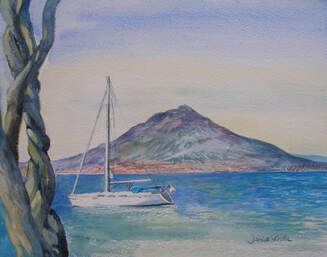
Autumn 2006: Sorrento, Amalfi, Positano and Praiano
It was September 2006. I was free at last, enjoying the luxury of travelling out of school holiday time. Arriving at Naples on the BA plane that leaves Gatwick at breakfast time, I felt even more than usual the excitement and joy to be back in the land of cheerful, robust, chattering families, dynamic road hogs, daredevil scooters and beautiful vistas around every corner.
I stayed in Sorrento again but this time only for part of my nine day visit. My first plan had been to spend the whole week in Amalfi and I had booked into the Hotel Il Nido in the Via S Quasimodo, up on the hill leading down into the town. I had intended to go to Sorrento for part of the time. I was aware that I had not yet explored the really old part of it, round the Marina Grande (the old fishing port). Drawing takes time, so my way of getting acquainted with places is a slow way.I'd booked a room in El Nido, on the coast road on the outskirts of Amalfi. When I got off the bus outside the station in Sorrento on September 3rd 2006 it was early afternoon and I had been travelling since 4am. Somehow the prospect of getting on a bus for Amalfi didn't appeal. Another consideration was that I was carrying a heavy case full of small mounted prints of my paintings which I was to deliver to the shop of Giovanna Petagna, in the Via dei Cesari in the centre of Sorrento. Since it was now 2.30 pm most of Sorrento was napping after lunch and all the shops were closed until about 6pm. Petagna's didn't normally open till even later.
I weighed up the best plan and decided that I must stay in Sorrento that night at least. I would go to see if the Hotel Lorelei (also known as the Hotel de Londre) had any rooms. This is a hotel positioned in the best spot along the cliffs of Sorrento, but I had discovered on my August visit that its rates were roughly half those of its neighbours. It had been fully booked then.
I trundled my case down the cobbles from the station to the Via A. Califano to look for a place for the night. The Lorelei Hotel seemed deserted. Its peeling pink stucco was baking in the hot afternoon sun. In the open air bamboo roofed terrace fronting on to the road, a dozing cat lifted its head to eye me sleepily and fell back into its dreams again. The sea glittered below, where the whole of the Marina Piccola lay out in the heat of the afternoon.
There was nobody about in the shabby entrance lounge. Somewhere I could hear the murmur of conversation and a muted clatter of pans - the kitchen clearing up after lunch. I put my head into the tiny cluttered office of the entrance hall and as I did so I saw out of the corner of my eye a movement across the hall towards the chipped marble staircase. "Signora! Per favore..." - my faltering Italian began. The maid stopped, looked nervously at me and came back. I summoned up my small command of the language and she looked more at ease but went to find the receptionist. Did they have any rooms for the same night? This question seemed difficult to answer immediately but I agreed to wait.
At length I was accepted. I decided to take the room for three nights and to go on to Amalfi after that. After a phone call to Il Nido it was all arranged - three nights in the Lorelei, then three nights in Amalfi, but I could not keep the room on the 9th and 10th September so I was to return to the Lorelei for two nights and go back to Il Nido for the last two on 11th and 12th.
In the Hotel Lorelei in the summer of 2005 you got what you paid for and no frills. No air con, no fancy little bottles of shampoo or shower caps, no big fluffy towels. What you got was a basic room and ensuite shower room with a balcony overlooking the most beautiful view of the Marina Piccola and the coastline stretching up towards Amalfi. You got a nice little terrace restaurant only marred by the traffic roaring past (the terrace stretches between the road and the edge of the cliff) with the same wonderful view. You got sleepy but pleasant service and an Italian breakfast of sweet rolls, cake and croissants with jam. You got a sadly run-down little jetty/ beach bar area with sun beds (you pay a little extra for this). It was ideal for me, with my limited financial resources.
Most people staying there seemed to be from other European countries. There was a very friendly French couple in the room next to me, who talked to me about the drawings I did each day when we met on our balconies. She was a designer and suggested places that they had visited that would make good subjects for my work. They too were very happy with the Lorelei. I overheard some grumbling from a rather overheated looking American couple but perhaps they had not expected to get only what they had paid for. I knew the value of the Lorelei's view.
In the event I only paid for four nights at the Lorelei, in money that is. I was flattered when the owner of the hotel, an elderly lady who spoke no English, asked me if she could buy a sketch I was making from the restaurant. I at first said "No" because I was not sure I could finish it properly and she didn't seem keen to pay what I would ask for it if I did finish it. At last I was persuaded to part with it for the price of one night in the hotel and we were both happy with that.
It was September 2006. I was free at last, enjoying the luxury of travelling out of school holiday time. Arriving at Naples on the BA plane that leaves Gatwick at breakfast time, I felt even more than usual the excitement and joy to be back in the land of cheerful, robust, chattering families, dynamic road hogs, daredevil scooters and beautiful vistas around every corner.
I stayed in Sorrento again but this time only for part of my nine day visit. My first plan had been to spend the whole week in Amalfi and I had booked into the Hotel Il Nido in the Via S Quasimodo, up on the hill leading down into the town. I had intended to go to Sorrento for part of the time. I was aware that I had not yet explored the really old part of it, round the Marina Grande (the old fishing port). Drawing takes time, so my way of getting acquainted with places is a slow way.I'd booked a room in El Nido, on the coast road on the outskirts of Amalfi. When I got off the bus outside the station in Sorrento on September 3rd 2006 it was early afternoon and I had been travelling since 4am. Somehow the prospect of getting on a bus for Amalfi didn't appeal. Another consideration was that I was carrying a heavy case full of small mounted prints of my paintings which I was to deliver to the shop of Giovanna Petagna, in the Via dei Cesari in the centre of Sorrento. Since it was now 2.30 pm most of Sorrento was napping after lunch and all the shops were closed until about 6pm. Petagna's didn't normally open till even later.
I weighed up the best plan and decided that I must stay in Sorrento that night at least. I would go to see if the Hotel Lorelei (also known as the Hotel de Londre) had any rooms. This is a hotel positioned in the best spot along the cliffs of Sorrento, but I had discovered on my August visit that its rates were roughly half those of its neighbours. It had been fully booked then.
I trundled my case down the cobbles from the station to the Via A. Califano to look for a place for the night. The Lorelei Hotel seemed deserted. Its peeling pink stucco was baking in the hot afternoon sun. In the open air bamboo roofed terrace fronting on to the road, a dozing cat lifted its head to eye me sleepily and fell back into its dreams again. The sea glittered below, where the whole of the Marina Piccola lay out in the heat of the afternoon.
There was nobody about in the shabby entrance lounge. Somewhere I could hear the murmur of conversation and a muted clatter of pans - the kitchen clearing up after lunch. I put my head into the tiny cluttered office of the entrance hall and as I did so I saw out of the corner of my eye a movement across the hall towards the chipped marble staircase. "Signora! Per favore..." - my faltering Italian began. The maid stopped, looked nervously at me and came back. I summoned up my small command of the language and she looked more at ease but went to find the receptionist. Did they have any rooms for the same night? This question seemed difficult to answer immediately but I agreed to wait.
At length I was accepted. I decided to take the room for three nights and to go on to Amalfi after that. After a phone call to Il Nido it was all arranged - three nights in the Lorelei, then three nights in Amalfi, but I could not keep the room on the 9th and 10th September so I was to return to the Lorelei for two nights and go back to Il Nido for the last two on 11th and 12th.
In the Hotel Lorelei in the summer of 2005 you got what you paid for and no frills. No air con, no fancy little bottles of shampoo or shower caps, no big fluffy towels. What you got was a basic room and ensuite shower room with a balcony overlooking the most beautiful view of the Marina Piccola and the coastline stretching up towards Amalfi. You got a nice little terrace restaurant only marred by the traffic roaring past (the terrace stretches between the road and the edge of the cliff) with the same wonderful view. You got sleepy but pleasant service and an Italian breakfast of sweet rolls, cake and croissants with jam. You got a sadly run-down little jetty/ beach bar area with sun beds (you pay a little extra for this). It was ideal for me, with my limited financial resources.
Most people staying there seemed to be from other European countries. There was a very friendly French couple in the room next to me, who talked to me about the drawings I did each day when we met on our balconies. She was a designer and suggested places that they had visited that would make good subjects for my work. They too were very happy with the Lorelei. I overheard some grumbling from a rather overheated looking American couple but perhaps they had not expected to get only what they had paid for. I knew the value of the Lorelei's view.
In the event I only paid for four nights at the Lorelei, in money that is. I was flattered when the owner of the hotel, an elderly lady who spoke no English, asked me if she could buy a sketch I was making from the restaurant. I at first said "No" because I was not sure I could finish it properly and she didn't seem keen to pay what I would ask for it if I did finish it. At last I was persuaded to part with it for the price of one night in the hotel and we were both happy with that.
I admit to spending at least one day on the sunbeds of the "beach" at the Lorelei. I also went to see the Petagnas in the shop where they make and sell prints and art materials. I had been flattered but taken aback in August when they had broken to me the news that they had used my painting of a Roman building, the Sedile Dominova, in a book that they had written and published, about the history of the Conservatorio di Maria delle Grazione. This is the convent that has its facade along one side of the Piazza San Francesco. (I had had some prints made at the shop back in the summer of 2005 and they had the image on their computer.) They gave me a copy of the book and I was pleased to see the full page reproduction of my painting on page 31.
They had also sold a number of my prints. I left them with prints of some of the work I had done during my August 2006 visit, including a view of the street outside their shop in August following Italy's World Cup win. I had painted this on the spot but then had to replace all the international flags which were really there with Italian flags, at Giovanna's request, for the local market's taste.
They had also sold a number of my prints. I left them with prints of some of the work I had done during my August 2006 visit, including a view of the street outside their shop in August following Italy's World Cup win. I had painted this on the spot but then had to replace all the international flags which were really there with Italian flags, at Giovanna's request, for the local market's taste.
................................
To Amalfi
On the fourth afternoon of my stay, I took the ferry to Amalfi and the Hotel Il Nido. I stood at the stern, watching the foaming trail we left behind us as the coastline to our left became more and more rugged and scenic. Mountains and islands passed by like one of those panoramic scenes painted on the background of a museum display about geological formations. I was joined by two members of the crew, one of whom decided to be my tour guide, pointing out the island that Rudolph Nureyev bought, the funicular down the cliff at Positano, the Martello towers that protected the coast in the war. Finally, egged on by his fellow crew member, he invited me to go out dancing with him in Amalfi that evening. I gracefully declined, the more easily since he was about half my age. But I was certainly flattered - a state of mind that a stay in Italy during the holiday season often produces and that I have learned to avoid taking too seriously, because it's just teasing.
As the ferry arrives at Amalfi you can see the facades of the Hotel Residence and the shops along the quay, the cars parked up to the railings and the buses that wait to take you up to the towns above Amalfi or back along the coast road towards Sorrento. It's a busy place in the summer. One of the beaches is to the right of the jetties for the ferries and there are others round the point on the Sorrento side of the town. The streets lead stiffly up the hills to each side and in the centre of the town they run through a system of stone tunnels and steps that are like catacombs to the newcomer's eye. Every few yards the covered ways emerge on to a small landing that has the stairs up to the front entrances of houses leading off it, or out into a piazza with shops and open streets.
The Hotel Il Nido is a very well run family hotel, about a kilometre's walk from the quay. Nearby was a strange anomaly in this part of Italy - a bar run by Willy, a Lancashireman, along British pub lines, stocking Guinness and other exotic British drinks as well as local wines and snacks. Willy was large, friendly and a little desperate. I got to know the place when I paused on my trudge up the hill after a day's drawing in Ravello or on the beach. There was always a group of friends there: Australians on their world travels; American students on their summer break; young Italians enjoying the summer tourist influx and practising their English (though Willy spoke fluent Italian). The television was always tuned to Sky sport, usually football and Willy would distribute fliers on the beach, particularly when an English team was playing. Sadly, Willy's Bar was closing at the end of the season and Willy was going back to settle down in his home county. He was truly deserving of the title "mine host". Order a glass of red wine and it was refilled for the rest of the evening like one of those magic cups in a fairy tale. The final account was always clearly in the customer's favour. I hope that his next venture has worked out well for him.
The owners of the Hotel il Nido were grave, professional and dignified, always ready to help and provide advice when asked. Their hotel was spotless, as almost all Italian hotels are, and they provided a good breakfast of cereal, buns. bread and croissants and cheese and ham. There was a lovely view across the bay from the dining room, the sparkling sea dazzling in the mornings.
My room was large and spacious with intriguing pictures of the local area on the walls. The young man who was often the night receptionist was the son of the owner. He spent the night gazing seriously at his computer, below the high counter where he sat. I never found out whether he was playing computer games, surfing the net or doing some kind of work. In the morning he would still be in the same place, with his night's growth of stubble the only evidence that time had passed. He was very helpful and admired my paintings as I brought them back to the hotel, weary and pleased with another day in Ravello, at the Villa Cimbrone or the Villa Rufolo.
When, on my last evening at Il Nido, I asked the night receptionist to order a taxi at six in the morning to take me down to the quay to catch the first ferry back to Sorrento, he insisted on driving me down the hill in his own car, leaving the reception unmanned for a few minutes. I promised to return to Il Nido and to tell anyone who would read my blog about the service that I had received there.
The Hotel Il Nido is a very well run family hotel, about a kilometre's walk from the quay. Nearby was a strange anomaly in this part of Italy - a bar run by Willy, a Lancashireman, along British pub lines, stocking Guinness and other exotic British drinks as well as local wines and snacks. Willy was large, friendly and a little desperate. I got to know the place when I paused on my trudge up the hill after a day's drawing in Ravello or on the beach. There was always a group of friends there: Australians on their world travels; American students on their summer break; young Italians enjoying the summer tourist influx and practising their English (though Willy spoke fluent Italian). The television was always tuned to Sky sport, usually football and Willy would distribute fliers on the beach, particularly when an English team was playing. Sadly, Willy's Bar was closing at the end of the season and Willy was going back to settle down in his home county. He was truly deserving of the title "mine host". Order a glass of red wine and it was refilled for the rest of the evening like one of those magic cups in a fairy tale. The final account was always clearly in the customer's favour. I hope that his next venture has worked out well for him.
The owners of the Hotel il Nido were grave, professional and dignified, always ready to help and provide advice when asked. Their hotel was spotless, as almost all Italian hotels are, and they provided a good breakfast of cereal, buns. bread and croissants and cheese and ham. There was a lovely view across the bay from the dining room, the sparkling sea dazzling in the mornings.
My room was large and spacious with intriguing pictures of the local area on the walls. The young man who was often the night receptionist was the son of the owner. He spent the night gazing seriously at his computer, below the high counter where he sat. I never found out whether he was playing computer games, surfing the net or doing some kind of work. In the morning he would still be in the same place, with his night's growth of stubble the only evidence that time had passed. He was very helpful and admired my paintings as I brought them back to the hotel, weary and pleased with another day in Ravello, at the Villa Cimbrone or the Villa Rufolo.
When, on my last evening at Il Nido, I asked the night receptionist to order a taxi at six in the morning to take me down to the quay to catch the first ferry back to Sorrento, he insisted on driving me down the hill in his own car, leaving the reception unmanned for a few minutes. I promised to return to Il Nido and to tell anyone who would read my blog about the service that I had received there.
Amalfi from the sea is backed by a rugged cliff scored with crevices and cracks, hung with stalactite like formations that run down to the road along the coast from Sorrento. There's a great shallow cave-like rock formation that frames the cathedral in some of my photographs, though in reality one is less conscious of it than of the intense blue sky above the dome. The cathedral (S. Stefano) is visible from most parts of the town, and especially from the beach in front of the ferry landing. Its green and yellow tiled campanile rises behind the white hotels and pastel washed buildings.
The Piazza Sant'Andrea in Amalfi is dominated by the facade of the Cathedral, dedicated to Saint Andrew. Its highly ornamented marble and brick facade and broad staircase leading up to the gallery along the facade are so often photographed that I was not inspired to paint the view from the piazza. Instead I composed this painting from the gallery itself, looking out on to the cafes and bars of the piazza. The most inspiring view of the facade was to be seen at night, when floodlights picked out the layers of decoration and paintings behind the arches. This view was hard to paint or photograph and I hope to master a technique for conveying the effect that I found so exciting, when I return to the area in 2006.
The Piazza Sant'Andrea in Amalfi is dominated by the facade of the Cathedral, dedicated to Saint Andrew. Its highly ornamented marble and brick facade and broad staircase leading up to the gallery along the facade are so often photographed that I was not inspired to paint the view from the piazza. Instead I composed this painting from the gallery itself, looking out on to the cafes and bars of the piazza. The most inspiring view of the facade was to be seen at night, when floodlights picked out the layers of decoration and paintings behind the arches. This view was hard to paint or photograph and I hope to master a technique for conveying the effect that I found so exciting, when I return to the area in 2006.
...............................................................................
2007 — Praiano & Positano — Exhibition opportunity...
In April 2007 I was offered an exhibition in the Buca di Bacco wine bar below the beach-side restaurant, when the manager, Davide, saw my work in progress and looked at the sketches of the landscape and seascape that I had done so far. I was cautiously optimistic about this and was very pleased when in the following week Davide confirmed that they would like it to go ahead. Originally I was asked to arrange it for the month of June 2007 but I had to explain that I am exhibiting work at my own studio as part of Surrey Open Studios from 11th to 21st June. We agreed that I would come out to Positano immediately after that and that the opening day of the exhibition would be 7th July 2007.
In April 2007 I was offered an exhibition in the Buca di Bacco wine bar below the beach-side restaurant, when the manager, Davide, saw my work in progress and looked at the sketches of the landscape and seascape that I had done so far. I was cautiously optimistic about this and was very pleased when in the following week Davide confirmed that they would like it to go ahead. Originally I was asked to arrange it for the month of June 2007 but I had to explain that I am exhibiting work at my own studio as part of Surrey Open Studios from 11th to 21st June. We agreed that I would come out to Positano immediately after that and that the opening day of the exhibition would be 7th July 2007.
I surveyed the gallery space and decided that I needed 10 large new canvases (at least 1 metre along one of their sides before framing) and at least 8 smaller ones. These would be based on the sketches I was doing and the photographs I was taking on my present trip. They must all be about the Amalfi Coast. I already had six or seven larger gouache paintings that I could bring over and frame here so that they are the right size. I also had at least twenty small original works at home to select from, and some signed digital prints on watercolour which can be offered at a less expensive price than the originals (which are unique, of course).
I booked an apartment at very reasonable price at the Continental for 6 weeks in June and July, and checked out the price of British Airways flights to Naples.
This all happened so quickly because of the encouragement I had from my friendship with Connie at the Miniaci Art Gallery in Positano. This is the Positano branch of a gallery that carries the work of internationally famous artists and has its main branch in Milan.
On Friday evening (20th April) Connie invited me to her home, down the road from where I am staying in Praiano, for supper. She has a very stylish but cosy little apartment and it really made me want to come and live in Praiano myself. (Perhaps, one day...) Connie had originally suggested Thursday for this meal, but we changed it because her little cat, Puskin, had to have an emergency operation on a tumour and needed all her attention this week.
"You must come and meet my little haggis!" said Connie on Friday, the day after the operation. That was Puskin, all stitched up and baggy after having the operation. We found her in pretty good spirits, though subdued. She managed a purr when I stroked her and became quite urgent about the fish that Connie cooked for her, in spite of a moment of suspicious sniffing as she caught a whiff of the antibiotic pill that had been mashed into it. Connie was concerned because Puskin was eating but not peeing or pooing, but a phone call to the vet set her mind at rest. (By today, Sunday, Puskin was leaping about as usual, and her innards had started to work properly again, Connie reported when I looked into the gallery that morning.)
As Connie began to cook us a supper of pasta with prawns and garlic, Elisa, her neighbour, looked in with a big basket of fruit that they had bought together - huge juicy oranges, enormous strawberries and organic apples. Elisa was invited to have supper with us and I was given a share of the fruit to take home, too. Elisa spoke no English. Connie is bilingual so we had one of those three-cornered conversations that I often have here at the moment. I can understand a certain amount of Italian and speak a little too, but a translator in both languages did speed the conversation up considerably.
We discussed accommodation costs for me in June and July and they both recommended striking a bargain with the owner of the pensione where I have now booked. I left at about 9pm, conscious that Connie had to work in the morning, after a really good evening with my new friends.
That was on Friday. On Saturday morning I got up early and walked down to the Continental. There I was introduced to Penelope, another artist who is arranging an exhibition of her paintings on silk, in Capri. Penelope was waiting for a promised lift to Positano with her ten large paintings, which she had brought with her as hold baggage with BA a few days ago. The owner of the pensione is a very old friend of hers (she has known him since he was six years old, they both confirmed), and he had offered to help her to take the work to the jetty in Positano where they would be picked up by someone from Capriart, the gallery that was their destination.
Penelope certainly knows her way around Italy much better than I do, and speaks perfect Italian because, she explained, she had once been married to an Italian and had lived in Italy. She introduced me to Lynn, who is an Australian staying for the week. Lynn is spending six weeks travelling round Italy, as one of her biennial globe-trottings.
We all got on so well, we decided to meet up in the evening for a drink at the Continental. That turned into a meal in the restaurant next door, in a lovely setting overlooking the sea. I showed them my work and was really pleased and flattered when Lynn bought an acrylic sketch on paper, to take home as a souvenir. We spent the evening laughing, beginning with Penelope's realisation that the restaurant was directly below her apartment terrace and if anyone took the trouble to look up they would look straight into her room. She hadn't realised the restaurant was there, because it is partly canopied over with straw.
"I think I may have been seen taking my bikini off on my terrace this afternoon" she said sheepishly. Overhearing, the waiter gave a loud guffaw and confirmed "Yes Signora, I saw you undressed today!" Only in Italy, we decided, would a waiter be so indiscreet and unselfconscious!
We compared ages and found that we were all virtually the same age. (We agreed that we are not getting any younger but didn't care.) We got through two bottles of wine between us and I felt no pain at all as I walked back up the hill to bed.
I booked an apartment at very reasonable price at the Continental for 6 weeks in June and July, and checked out the price of British Airways flights to Naples.
This all happened so quickly because of the encouragement I had from my friendship with Connie at the Miniaci Art Gallery in Positano. This is the Positano branch of a gallery that carries the work of internationally famous artists and has its main branch in Milan.
On Friday evening (20th April) Connie invited me to her home, down the road from where I am staying in Praiano, for supper. She has a very stylish but cosy little apartment and it really made me want to come and live in Praiano myself. (Perhaps, one day...) Connie had originally suggested Thursday for this meal, but we changed it because her little cat, Puskin, had to have an emergency operation on a tumour and needed all her attention this week.
"You must come and meet my little haggis!" said Connie on Friday, the day after the operation. That was Puskin, all stitched up and baggy after having the operation. We found her in pretty good spirits, though subdued. She managed a purr when I stroked her and became quite urgent about the fish that Connie cooked for her, in spite of a moment of suspicious sniffing as she caught a whiff of the antibiotic pill that had been mashed into it. Connie was concerned because Puskin was eating but not peeing or pooing, but a phone call to the vet set her mind at rest. (By today, Sunday, Puskin was leaping about as usual, and her innards had started to work properly again, Connie reported when I looked into the gallery that morning.)
As Connie began to cook us a supper of pasta with prawns and garlic, Elisa, her neighbour, looked in with a big basket of fruit that they had bought together - huge juicy oranges, enormous strawberries and organic apples. Elisa was invited to have supper with us and I was given a share of the fruit to take home, too. Elisa spoke no English. Connie is bilingual so we had one of those three-cornered conversations that I often have here at the moment. I can understand a certain amount of Italian and speak a little too, but a translator in both languages did speed the conversation up considerably.
We discussed accommodation costs for me in June and July and they both recommended striking a bargain with the owner of the pensione where I have now booked. I left at about 9pm, conscious that Connie had to work in the morning, after a really good evening with my new friends.
That was on Friday. On Saturday morning I got up early and walked down to the Continental. There I was introduced to Penelope, another artist who is arranging an exhibition of her paintings on silk, in Capri. Penelope was waiting for a promised lift to Positano with her ten large paintings, which she had brought with her as hold baggage with BA a few days ago. The owner of the pensione is a very old friend of hers (she has known him since he was six years old, they both confirmed), and he had offered to help her to take the work to the jetty in Positano where they would be picked up by someone from Capriart, the gallery that was their destination.
Penelope certainly knows her way around Italy much better than I do, and speaks perfect Italian because, she explained, she had once been married to an Italian and had lived in Italy. She introduced me to Lynn, who is an Australian staying for the week. Lynn is spending six weeks travelling round Italy, as one of her biennial globe-trottings.
We all got on so well, we decided to meet up in the evening for a drink at the Continental. That turned into a meal in the restaurant next door, in a lovely setting overlooking the sea. I showed them my work and was really pleased and flattered when Lynn bought an acrylic sketch on paper, to take home as a souvenir. We spent the evening laughing, beginning with Penelope's realisation that the restaurant was directly below her apartment terrace and if anyone took the trouble to look up they would look straight into her room. She hadn't realised the restaurant was there, because it is partly canopied over with straw.
"I think I may have been seen taking my bikini off on my terrace this afternoon" she said sheepishly. Overhearing, the waiter gave a loud guffaw and confirmed "Yes Signora, I saw you undressed today!" Only in Italy, we decided, would a waiter be so indiscreet and unselfconscious!
We compared ages and found that we were all virtually the same age. (We agreed that we are not getting any younger but didn't care.) We got through two bottles of wine between us and I felt no pain at all as I walked back up the hill to bed.
................................................................
Drawing in Ravello
Connie had introduced me to painter friends who spent their summers painting on the sea-front in Positano and I was spending days drawing and painting alongside them. They were friendly and helpful (and Pasquale even lent me a white umbrella to attach to my easel, which was required equipment among the group. —I later had to go to Naples to buy a replacement for him, because it became a bit worse for wear through daily travel to and from Praiano).
In April I was becoming bored with drawing on the beach at Positano, though I reminded myself that I would look back in amazement at this statement after being back home in England for a few days. So on Monday 23rd I decided to get the bus to Amalfi and then up to Ravello. My plan was to go into the shop that had shown an interest in my work last October and see if the owner was there.
Folio in hand, I set off on the Sita bus. I had forgotten what a beautiful road it is between Praiano and Amalfi. With the sea on your left all the way, you pass fantastically formed stacks jutting out into the bay, deep gullies (as at Furore, the next town after Praiano) and the entrance to the Grotta dello Smeralda, a spectacular hollow in the coast line with a lift down to the caves below. You can go there by boat, too. I haven't done this because it really is too much of a tourist trap for my liking in the summer, but today it looked beautiful from above, the sea deep bottle green and purple in the shadows. I tried some photographs but without breaking my journey and getting out of the bus I couldn't achieve a good result. I resolved that when I came back in June I would explore that part of the coast road with my camera and sketch book.
At Amalfi I changed buses and was entertained by the beginning of World War III between a German and an Englishman about who should get on to the bus first. I was sitting smugly in a seat when this blew up. It got quite physical and the bus driver had to intervene —I felt rather ashamed for my compatriot, who seemed to be seriously over-reacting to the situation. (He calmed down when the German had to get off anyway because there wasn't room for the whole of the party that he was travelling with.)
The ride up to Ravello was even more spectacular than I remembered, even though it was a slightly hazy day. The road winds up the edge of a deep gorge. Looking down, you can see houses and chapels perched on ledges in the valley - I always wonder at the logistics of building in such terrain.
Above Amalfi are three villages— Pontone, which you can reach on foot by walking up from Amalfi; Scala, a peaceful unspoilt place (where last year I took my favourite wedding photo ever when the bus stopped outside the church one day) and Ravello, very pretty, full of flowers, sophisticated restaurants and hotels and two lovely mediaeval villas with gardens overlooking the sea, many metres below them, the Villa Rufolo and the Villa Cimbrone. There is a pretty piazza with the Cathedral dedicated to S. Pantaleone, and the church and library of San Francesco is up the hill on the way to the Villa Cimbrone. This is the view of the Villa Rufolo looking back from that street..... The tower is the watchtower that I painted last October, when the creeper that grows up it was turning to shades of crimson and gold. The cloister and the arched temple are at the Villa Cimbrone.
In April I was becoming bored with drawing on the beach at Positano, though I reminded myself that I would look back in amazement at this statement after being back home in England for a few days. So on Monday 23rd I decided to get the bus to Amalfi and then up to Ravello. My plan was to go into the shop that had shown an interest in my work last October and see if the owner was there.
Folio in hand, I set off on the Sita bus. I had forgotten what a beautiful road it is between Praiano and Amalfi. With the sea on your left all the way, you pass fantastically formed stacks jutting out into the bay, deep gullies (as at Furore, the next town after Praiano) and the entrance to the Grotta dello Smeralda, a spectacular hollow in the coast line with a lift down to the caves below. You can go there by boat, too. I haven't done this because it really is too much of a tourist trap for my liking in the summer, but today it looked beautiful from above, the sea deep bottle green and purple in the shadows. I tried some photographs but without breaking my journey and getting out of the bus I couldn't achieve a good result. I resolved that when I came back in June I would explore that part of the coast road with my camera and sketch book.
At Amalfi I changed buses and was entertained by the beginning of World War III between a German and an Englishman about who should get on to the bus first. I was sitting smugly in a seat when this blew up. It got quite physical and the bus driver had to intervene —I felt rather ashamed for my compatriot, who seemed to be seriously over-reacting to the situation. (He calmed down when the German had to get off anyway because there wasn't room for the whole of the party that he was travelling with.)
The ride up to Ravello was even more spectacular than I remembered, even though it was a slightly hazy day. The road winds up the edge of a deep gorge. Looking down, you can see houses and chapels perched on ledges in the valley - I always wonder at the logistics of building in such terrain.
Above Amalfi are three villages— Pontone, which you can reach on foot by walking up from Amalfi; Scala, a peaceful unspoilt place (where last year I took my favourite wedding photo ever when the bus stopped outside the church one day) and Ravello, very pretty, full of flowers, sophisticated restaurants and hotels and two lovely mediaeval villas with gardens overlooking the sea, many metres below them, the Villa Rufolo and the Villa Cimbrone. There is a pretty piazza with the Cathedral dedicated to S. Pantaleone, and the church and library of San Francesco is up the hill on the way to the Villa Cimbrone. This is the view of the Villa Rufolo looking back from that street..... The tower is the watchtower that I painted last October, when the creeper that grows up it was turning to shades of crimson and gold. The cloister and the arched temple are at the Villa Cimbrone.
Having visited the shop in the via San Francesco and been told by Nicoletta that the owner would be there on Wednesday afternoon, I went on up the hill, intending to visit the Villa Cimbrone again. As I passed Villa Maria on my left, I glanced into the terrace and saw a fantastic view that took in Pontone and Scala and another settlement whose name I don't know yet. The view stretched right across the terraced mountainsides to the sea. The horizon was hidden in the haze. I decided that this would be my subject for today and went and chose a table next to the railings of the terrace. The place was almost deserted and I was impressed to find that the waiters were tactful enough to let me start drawing without insisting that I commit myself to even a cup of coffee.
After a while I asked for the menu and ordered some delicious pasta (borboni) and a glass of wine. Music was put on at midday — a medley of Mozart and other popular classics - so restful! I had the most relaxing and enjoyable day and completed two A3 ink drawings which will be the basis (together with photos) for an oil painting. I met a very friendly Danish couple at the next table, who were camping nearby, and at their request gave them my card - I didn't want to sell either drawing until I had used them, so I promised to upload them to my website to let them see them when they go back to Denmark.
I expected the bill to be high - I had a big dish of chocolate ice cream with a fancy flag in the top, and three espressos, as well at the main meal of pasta. But it was only average, and much less than in some much more mediocre restaurants.
Coming back to Praiano, the buses connected, the driver allowed me to get off right outside my hotel - it had been one of those good days!
I expected the bill to be high - I had a big dish of chocolate ice cream with a fancy flag in the top, and three espressos, as well at the main meal of pasta. But it was only average, and much less than in some much more mediocre restaurants.
Coming back to Praiano, the buses connected, the driver allowed me to get off right outside my hotel - it had been one of those good days!
..................................................
The weather was becoming hazy and cooler, though it was still pleasant. On Tuesday I decided to go back to Positano for the last time on this trip (I wanted to go back to Ravello on Wednesday and would be flying home on Thursday).
Walking into Vettica to catch a bus to Positano, I took some photos of the model village that an artist has set up under the rocks at the Grotta del Diavolo. These little installations are a common sight in the Amalfi area and the notice that accompanies this one speaks of the democratic right of the artist to set up his work in the natural surroundings of his homeland - or I think that's what it says. The model layouts always include the church. In this one it is tucked behind a special gate at a slight remove from the main model. Passers by usually stop to peer in reverently.
Walking into Vettica to catch a bus to Positano, I took some photos of the model village that an artist has set up under the rocks at the Grotta del Diavolo. These little installations are a common sight in the Amalfi area and the notice that accompanies this one speaks of the democratic right of the artist to set up his work in the natural surroundings of his homeland - or I think that's what it says. The model layouts always include the church. In this one it is tucked behind a special gate at a slight remove from the main model. Passers by usually stop to peer in reverently.
I caught the bus to Positano without problems and got off at the stop just the other side of the main road down to the town. where I knew I could buy a very reasonably priced mozzarella and ham roll for lunch. I found another alternative route down to the beach area, avoiding the road entirely and descending past the pastel washed houses and wrought iron balconies on the other side of the beach, nearer to the jetty where the Capri and Sorrento ferries dock. I took photographs as I went, planning the collage that I might make with the prints, to form the basis for a painting.
I came out of the streets down on the beach below the Duomo, near the other big cafe-restaurant there, Le Tre Sorelli. I realised that I had temporarily become a local character, when the waiters there greeted me and asked me what I was painting today. (I have never eaten there or spoken to any of them before. I think that my "English lady" hat has a lot to do with this status. I wear it to protect my hair from fading in the sun and it has become something of a trademark, I think). There was a cry of "Jan! Lovely to see you" and there was Lynn, looking very chic, with several shopping bags from her trip round the boutiques. We agreed to meet that evening at the Continental Hotel in Praiano, where I was staying. For the rest of the day I intended to draw and Lynn was in shopping mode.
For this last day in Positano I tried again to encapsulate the extraordinary heap of Moorish style buildings that is the town of Positano as seen from the beach. The artists of Positano have found ways of doing this and perhaps it's unwise, as well as unnecessary, for me to attempt to do it. Nevertheless, I laboured for two or three hours over an ink drawing in my sketch book, reasoning that the more familiar I become with the problem, the greater my chances of pinning it down. But it didn't happen for me, not this time.
For this last day in Positano I tried again to encapsulate the extraordinary heap of Moorish style buildings that is the town of Positano as seen from the beach. The artists of Positano have found ways of doing this and perhaps it's unwise, as well as unnecessary, for me to attempt to do it. Nevertheless, I laboured for two or three hours over an ink drawing in my sketch book, reasoning that the more familiar I become with the problem, the greater my chances of pinning it down. But it didn't happen for me, not this time.
*
On 26th April I said "á rivederci" to Pasquale, Andrea and Domenico as they painted on the piazza outside the Buca di Bacco. Pasquale told me that he would help me to arrange the exhibition by taking me to the framer's and art suppliers when I come back in the last week in June. Then I went up to the Galleria Miniaci to say goodbye to Connie. She was finishing her day and offered me a lift back to Praiano. I accepted gratefully.
It was still early evening when I got back to Vettica Praiano and the soft haze hid the horizon. The church of San Genaro stood against the haze, opposite the stop where I had often waited for the bus. I realised that I had not properly explored San Genaro and I took the few steps down towards the sea that brought me to the Piazza San Genaro, a wide platform in front of the church, perched above the sea. The piazza was full of families and young people, playing football and chatting in the twilight. It was too dark for a good photograph. I had neglected the most important view in Praiano. I would have to correct this huge oversight in June.
I went up to the Trattoria San Genaro which is between the road and the church. Its small terrace has tables that overlook the sea and also the roof of the church. It's in a lovely position, on eye-level with the carvings and tiles, with the green and yellow dome just above. Another mental note - drawing here would be an interesting project. I had a supper of anchovies and a salad which was reasonably priced but rather oily, then walked back, feeling very tired.
Wednesday 25th April was my last full day in Italy for a while. It was Liberation Day, a bank holiday. Not a good day to travel but I wanted to go to Ravello again in case Nicoletta, in the gallery in the via San Francesca, had been right when she said that the patrone would be there today. It did seem unlikely and in the event he was not. The weather was unsettled and the buses were crammed with passengers. Arriving in Amalfi to pick up the connection to Ravello, I saw that there was almost no queue, so I had obviously just missed a bus. I went down on the beach, with the bus queue in sight, and settled down to sleep in the interval of sunshine that broke through the cloud. An hour later I surfaced to see a queue of respectable length had formed for the Ravello bus and as I went to join it the bus turned up.
I was disappointed that the owner of the gallery was not there, and disillusioned with Ravello which looked almost tawdry on the bank holiday. The piazza was crowded with day trippers and the gift shops all seemed to be full of the same decorated ceramic ashtrays and limoncello glasses. (Nevertheless, there are some beautiful things made in glass and ceramic in Italy, which sell at very high prices and are to be found in the shops away from the main piazza in Ravello.)
I was surprised and grateful when the driver of the bus from Amalfi to Praiano, which connected immediately I got off the Ravello bus, let me on. It was so packed that I had to stand on the step into the bus and was almost leaning on his driving arm for a few stops. I regard the bus drivers of the Amalfi Coast as heroes, especially on bank holidays.
It was still early evening when I got back to Vettica Praiano and the soft haze hid the horizon. The church of San Genaro stood against the haze, opposite the stop where I had often waited for the bus. I realised that I had not properly explored San Genaro and I took the few steps down towards the sea that brought me to the Piazza San Genaro, a wide platform in front of the church, perched above the sea. The piazza was full of families and young people, playing football and chatting in the twilight. It was too dark for a good photograph. I had neglected the most important view in Praiano. I would have to correct this huge oversight in June.
I went up to the Trattoria San Genaro which is between the road and the church. Its small terrace has tables that overlook the sea and also the roof of the church. It's in a lovely position, on eye-level with the carvings and tiles, with the green and yellow dome just above. Another mental note - drawing here would be an interesting project. I had a supper of anchovies and a salad which was reasonably priced but rather oily, then walked back, feeling very tired.
Wednesday 25th April was my last full day in Italy for a while. It was Liberation Day, a bank holiday. Not a good day to travel but I wanted to go to Ravello again in case Nicoletta, in the gallery in the via San Francesca, had been right when she said that the patrone would be there today. It did seem unlikely and in the event he was not. The weather was unsettled and the buses were crammed with passengers. Arriving in Amalfi to pick up the connection to Ravello, I saw that there was almost no queue, so I had obviously just missed a bus. I went down on the beach, with the bus queue in sight, and settled down to sleep in the interval of sunshine that broke through the cloud. An hour later I surfaced to see a queue of respectable length had formed for the Ravello bus and as I went to join it the bus turned up.
I was disappointed that the owner of the gallery was not there, and disillusioned with Ravello which looked almost tawdry on the bank holiday. The piazza was crowded with day trippers and the gift shops all seemed to be full of the same decorated ceramic ashtrays and limoncello glasses. (Nevertheless, there are some beautiful things made in glass and ceramic in Italy, which sell at very high prices and are to be found in the shops away from the main piazza in Ravello.)
I was surprised and grateful when the driver of the bus from Amalfi to Praiano, which connected immediately I got off the Ravello bus, let me on. It was so packed that I had to stand on the step into the bus and was almost leaning on his driving arm for a few stops. I regard the bus drivers of the Amalfi Coast as heroes, especially on bank holidays.
In the evening I walked down the hill to the hotel where I had met Lynn and Penelope. Penelope had finished her business with Capriart and gone back to Surrey. Lynn was in Praiano until Saturday, then she was taking the train to Florence via Salerno. We spent the evening with the brothers who own the Continental and two German ladies, long-term patrons of the pensione and friends of the brothers. We had a conversation in English, Italian and German about a number of matters, including as I remember, art, the Norman conquest of England and the philology of the English language. As none of us (especially I) was an expert in either history or philology, this was only possible through the lubrication of the excellent white wine. It was a good evening to round off my trip and I said goodbye with regret.
My trip home next day was uneventful. Now my work would begin, to get ready for the exhibition in July.
My trip home next day was uneventful. Now my work would begin, to get ready for the exhibition in July.
..............................................
Angela
Each time I go to the Amalfi Coast I understand a little more of what I love about the place and its inhabitants. I meet tourists like myself as well, from all over the world, and my diaries are a way of keeping all the experiences fresh in my own mind. I write daily notes for an illustrated article that I publish here when I get back to my computer. This is the diary of my trip to the Praiano and Positano areas in April 2006
There are 422 steep stone steps between the main coast road bus stop at S Genaro and the beach at Vettica, Praiano. I trod those steps six times in the first two days of my holiday. I discovered the beach when I went out to get some shampoo on my first morning in Praiano, on Thursday, and was diverted down the Via Russolo by curiosity. Led further and further on by signs "alla Spiaggia", I found myself at the bottom with no materials or camera, confronted by a fantastic view of deep emerald and purple sea, distant islands, limestone cliffs and a Martello tower perched romantically at the edge of the little bay. So up I went again, and a little while (and 844 steps up and down the cliff) later I was settled on the concrete platform which Praiano calls its beach.
That day I completed two small colour sketches in acrylic paint on Bockingford paper. I was joined by Rudi and his wife, who took a kind interest in what I was doing and in the afternoon introduced me to a party who had been to Capri on the boat driven by Mario, the owner of the hotel that I had included in one of my pictures.
The Bellavista caters for German tourists in particular so I was forced to use my dreadful Italian and even worse German language skills to be sociable. All the staff speak German rather than English - though most of the guests spoke fluent English too. The next day, Friday 13th, I was to go to Capri on Mario's boat as a paying customer. Unfortunately I was five minutes late and in efficient German mode, the boat left without me. Luckily I hadn't paid in advance, so I thought I would go on the public boat, another day. I was looking forward to it, because Capri is so crowded in the summer that when I went last, in August 2005, I couldn't see anything very much and was forced to hold my camera above my head to take photos of the places and buildings.
The Bellavista caters for German tourists in particular so I was forced to use my dreadful Italian and even worse German language skills to be sociable. All the staff speak German rather than English - though most of the guests spoke fluent English too. The next day, Friday 13th, I was to go to Capri on Mario's boat as a paying customer. Unfortunately I was five minutes late and in efficient German mode, the boat left without me. Luckily I hadn't paid in advance, so I thought I would go on the public boat, another day. I was looking forward to it, because Capri is so crowded in the summer that when I went last, in August 2005, I couldn't see anything very much and was forced to hold my camera above my head to take photos of the places and buildings.
So I sat down on the beach again - I wasn't going back up those steps empty handed — and settled down to make a painting on the little canvas I had packed in readiness for Capri. As I worked I heard a whistled tune coming from somewhere out of sight. After a while I heard "Ciao!" and looked round to see a camera trained on me by a girl carrying a great sheaf of leaves and flowers. Her face was very brown and she was grinning widely. This was Angela from Bulgaria.
I have never met anyone so skilled in making friends as Angela. She was the most charming companion from the first "Come si chiama?" ("What's your name?") to the end of the day by which time we were using the familiar "tu" and had had a really good laugh about all kinds of things. This was despite the fact that she neither spoke nor understood a single word of English - and my Italian is nearly as bad.
Angela arrived, whistling tunefully through her teeth, laden with plants and flowers she had gathered from the gardens on the way down the steps to the beach, and made friends with me in a most purposeful way that was, nevertheless, utterly disarming.
Angela is Bulgarian but she has been in Italy for about a year. She told me that she had been in Praiano before that, though, and had worked for the Bellavista Hotel before going home to Bulgaria for a while - my Italian was not up to understanding the reason.
We spent the whole day in creativity and conversation. Our conversation was conducted mostly in bad Italian and sign language, with a little French. My Italian was marginally better than her English - which was nonexistent - but we were both very good at sign language. In sign -language we agreed on many things, ranging from politics to art to men to life in general. We agreed that we both liked the Rolling Stones and Pink Floyd. Angela rummaged in her memory for an English author and came up with Gerald Durrell - who is, actually, one of my favourites from the past.
I have never met anyone so skilled in making friends as Angela. She was the most charming companion from the first "Come si chiama?" ("What's your name?") to the end of the day by which time we were using the familiar "tu" and had had a really good laugh about all kinds of things. This was despite the fact that she neither spoke nor understood a single word of English - and my Italian is nearly as bad.
Angela arrived, whistling tunefully through her teeth, laden with plants and flowers she had gathered from the gardens on the way down the steps to the beach, and made friends with me in a most purposeful way that was, nevertheless, utterly disarming.
Angela is Bulgarian but she has been in Italy for about a year. She told me that she had been in Praiano before that, though, and had worked for the Bellavista Hotel before going home to Bulgaria for a while - my Italian was not up to understanding the reason.
We spent the whole day in creativity and conversation. Our conversation was conducted mostly in bad Italian and sign language, with a little French. My Italian was marginally better than her English - which was nonexistent - but we were both very good at sign language. In sign -language we agreed on many things, ranging from politics to art to men to life in general. We agreed that we both liked the Rolling Stones and Pink Floyd. Angela rummaged in her memory for an English author and came up with Gerald Durrell - who is, actually, one of my favourites from the past.
Angela was of the opinion that men named Mario are bad news and she had a photo to prove it — the Mario from Amalfi that she showed me certainly looked "bruto" as she described him. She expressed her feelings by taking her lighter and burning the corner of Mario's picture - "Pauvero Mario!"
She spoke very differently about the man who phoned her several times on her mobile, obviously concerned to check that she was safe. This was Francesco Mangieri, a ceramicist and sculptor with an exhibition in Amalfi now. She gave me a card with his photo and address and asked me to publicise his address: 7 - Piazzetta C. Console, 7 - 84011 (Tel. 089-871929).
Angela was clearly an artist herself and what she made with the plants that she brought back from her periodic "shopping" trips (her term) would stand comparison with the best florist's - or land artist's - work. She obviously preferred the life of a land artist and she decked the cliff behind her with examples of her art. She collected pebbles, seaweed, flotsam and jetsam and even crabs, to add to her display. When we left the beach the fishing boat that was beached there was Angela's exhibition space.
Angela wove crowns of aromatic plants for herself and for me, and we laughed at ourselves and each other as we modelled them like children. We took photos of each other and I chronicled her work as it progressed. Angela kept us both sustained with sachets of acacia honey which she produced from her big orange bag. She had a supply of information in the bag, too: cards from galleries and hotels and brochures and pamphlets on all kinds of subjects. Some she gave to me, and I received them gratefully. Luis, the fisherman attached to the Bellavista Hotel, arrived on the beach in the afternoon and he and Angela had a long serious conversation in Italian which I couldn't follow. He obviously admired her work and I photographed him with sections of it.
I wanted to write about Angela because she seems to me a model of a free-spirited but vulnerable woman who (apart from stealing a few flowers from private gardens) is quite without guile and yet strong and capable of surviving in a difficult world. I wish her as much success as possible in this life. I'm glad that I missed the boat to Capri - if I hadn't, I wouldn't have had the pleasure of meeting her.
She spoke very differently about the man who phoned her several times on her mobile, obviously concerned to check that she was safe. This was Francesco Mangieri, a ceramicist and sculptor with an exhibition in Amalfi now. She gave me a card with his photo and address and asked me to publicise his address: 7 - Piazzetta C. Console, 7 - 84011 (Tel. 089-871929).
Angela was clearly an artist herself and what she made with the plants that she brought back from her periodic "shopping" trips (her term) would stand comparison with the best florist's - or land artist's - work. She obviously preferred the life of a land artist and she decked the cliff behind her with examples of her art. She collected pebbles, seaweed, flotsam and jetsam and even crabs, to add to her display. When we left the beach the fishing boat that was beached there was Angela's exhibition space.
Angela wove crowns of aromatic plants for herself and for me, and we laughed at ourselves and each other as we modelled them like children. We took photos of each other and I chronicled her work as it progressed. Angela kept us both sustained with sachets of acacia honey which she produced from her big orange bag. She had a supply of information in the bag, too: cards from galleries and hotels and brochures and pamphlets on all kinds of subjects. Some she gave to me, and I received them gratefully. Luis, the fisherman attached to the Bellavista Hotel, arrived on the beach in the afternoon and he and Angela had a long serious conversation in Italian which I couldn't follow. He obviously admired her work and I photographed him with sections of it.
I wanted to write about Angela because she seems to me a model of a free-spirited but vulnerable woman who (apart from stealing a few flowers from private gardens) is quite without guile and yet strong and capable of surviving in a difficult world. I wish her as much success as possible in this life. I'm glad that I missed the boat to Capri - if I hadn't, I wouldn't have had the pleasure of meeting her.
A wet day in Sorrento
Having enjoyed two hot days I was disappointed to find it raining and cold on Saturday. I decided to go to Sorrento on the bus, to say "Ciao" to my friend Giovanna in her shop in the Via dei Cesari and to buy a new adaptor plug because the one I had brought with me was damaged. As usual, I also took my folio, including some spare paper, and some drawing materials, just in case the weather cleared.
This was not a successful day. I found that Giovanna had not sold any more of my prints. The weather stayed cold and wet. I lost my umbrella and had to buy a new one for 3 euros (the one I lost had cost me 12 GBP at the airport, though). I spent 39 euros on a rainproof jacket that probably looks as cheap as it was.
I did manage to make an ink drawing in a break in the showers, down at the Marina Grande. I did find a cheap internet point. And I didn't miss the last bus back to Praiano. So on balance, this was not an unsuccessful day either
This was not a successful day. I found that Giovanna had not sold any more of my prints. The weather stayed cold and wet. I lost my umbrella and had to buy a new one for 3 euros (the one I lost had cost me 12 GBP at the airport, though). I spent 39 euros on a rainproof jacket that probably looks as cheap as it was.
I did manage to make an ink drawing in a break in the showers, down at the Marina Grande. I did find a cheap internet point. And I didn't miss the last bus back to Praiano. So on balance, this was not an unsuccessful day either
A Cycle Race and sun in Positano
The following day, Sunday, on the other hand, was great. After the cold and rainy yesterday, the weather was perfect and I decided to go to Positano where I had made some friends last month. I took some drawing paper and a little canvas with me, and a few of my pieces of finished work, and set off into the village of Vettica Praiano to catch the bus. My pensione is about 10 minutes from the centre and though there is a bus stop in between, I wanted to do some things in the centre first.
I found a crowd of German holiday makers from the Bellavista Hotel waiting for the bus and within a few moments we realised that this was going to be a long wait. A car announcing the progress of a cycle race from Amalfi to Sorrento drove past, followed by two very fit racing cyclists, then a long pause.
We were all quite excited when a whole crowd of cyclists sped past, and we began clapping and cheering them on. It soon became clear that there were hundreds of competitors, strung out along the mountainous coast road, and that no buses would be coming by for quite a while. We accepted the inevitable and settled down to cheer them all on as they went flying - or in some cases, toiling - past. We felt obliged to encourage all of them, especially the back-markers, some of whom looked too old or too well-fed to be cycling at 45 degrees up hills. They responded variously by calling back "Grazie", waving an arm, taking both hands off the handlebars and looking very bouncy, or just gritting their teeth and trying to conserve their energy and breath (which is what I would have done in their place).
Eventually the bus arrived, an hour and a quarter late, and we were on our way.
I found a crowd of German holiday makers from the Bellavista Hotel waiting for the bus and within a few moments we realised that this was going to be a long wait. A car announcing the progress of a cycle race from Amalfi to Sorrento drove past, followed by two very fit racing cyclists, then a long pause.
We were all quite excited when a whole crowd of cyclists sped past, and we began clapping and cheering them on. It soon became clear that there were hundreds of competitors, strung out along the mountainous coast road, and that no buses would be coming by for quite a while. We accepted the inevitable and settled down to cheer them all on as they went flying - or in some cases, toiling - past. We felt obliged to encourage all of them, especially the back-markers, some of whom looked too old or too well-fed to be cycling at 45 degrees up hills. They responded variously by calling back "Grazie", waving an arm, taking both hands off the handlebars and looking very bouncy, or just gritting their teeth and trying to conserve their energy and breath (which is what I would have done in their place).
Eventually the bus arrived, an hour and a quarter late, and we were on our way.
Positano was in full holiday mode - quite a difference from the last time I had been there. That was on March 6th, when the streets were more like waterfalls and the sky was leaden. It was a cheerful sight this Sunday, down at the beach, where my artist friends greeted me warmly and asked me what my latest work was like. Pasquale Volpe, whom I had met two years ago, remembered me and was very encouraging about the pieces I had brought with me. He had some beautiful watercolour paintings of the town, which I admired. Pasquale has taken an art history course in England (Sheffield I think) and is full of praise for the English art education system.
Today I was using acrylic paint and it was drying almost as fast as I could dip the brush in it. Not an easy medium in the sun, but more convenient for carrying about, than oil paint. I found myself on a learning curve; I hadn't used acrylic paint for several years before this holiday.
At about four o'clock I decided to take a break and went to the restaurant on the beach that has an internet point and very sympathetic waiters. When I had finished my coffee, I asked the head waiter if I could draw the scene in the cafe. (I have been asked to paint a cafe scene by someone who visited my stall in Walton on Easter Monday and I thought the sketch might give me a starting point). This was the first of several days of drawing in and around the beach cafés and it led to the invitation by the manager to exhibit pictures in the wine bar below the restaurant, that I have written about earlier.
I painted the pictures for the exhibition when I went home, from the drawings, photos and colour sketches I collected in the months before the exhibition. I sent the finished work back to Italy, some to be framed there. Here's a selection of them.
At about four o'clock I decided to take a break and went to the restaurant on the beach that has an internet point and very sympathetic waiters. When I had finished my coffee, I asked the head waiter if I could draw the scene in the cafe. (I have been asked to paint a cafe scene by someone who visited my stall in Walton on Easter Monday and I thought the sketch might give me a starting point). This was the first of several days of drawing in and around the beach cafés and it led to the invitation by the manager to exhibit pictures in the wine bar below the restaurant, that I have written about earlier.
I painted the pictures for the exhibition when I went home, from the drawings, photos and colour sketches I collected in the months before the exhibition. I sent the finished work back to Italy, some to be framed there. Here's a selection of them.
December 2007 — La Spiaggia, Positano
Stage 1
I thought I'd post my present work in progress though it's at a very early stage and it will certainly change a lot before it's finished. The people in the foreground will need some redrawing as I fill in the surrounding areas, I realise. Now that I see the photo of it on the screen I can appreciate the composition in a different way. My art dealer friend in Sorrento warned me firmly against including people in paintings but for this subject - Positano Beach - I don't see how I can avoid including bathers. Perhaps I should give the painting artistic respectability by entitling it "Bathers" following the example of Picasso, Cezanne and Renoir (to name but a few.)
Stage 1
I thought I'd post my present work in progress though it's at a very early stage and it will certainly change a lot before it's finished. The people in the foreground will need some redrawing as I fill in the surrounding areas, I realise. Now that I see the photo of it on the screen I can appreciate the composition in a different way. My art dealer friend in Sorrento warned me firmly against including people in paintings but for this subject - Positano Beach - I don't see how I can avoid including bathers. Perhaps I should give the painting artistic respectability by entitling it "Bathers" following the example of Picasso, Cezanne and Renoir (to name but a few.)
Stage 2
This is after another couple of hours during which I realised that I'd drawn the left hand side of the beach on a different scale and level from the right. This affected the lowest level of the town buildings too, of course. Moral: check that your drawing is accurate before you start to paint, unless you want to do a lot of time-consuming repainting! I am encouraged by my friends' comments to put in plenty of people on the beach, which I'll enjoy doing!
This is after another couple of hours during which I realised that I'd drawn the left hand side of the beach on a different scale and level from the right. This affected the lowest level of the town buildings too, of course. Moral: check that your drawing is accurate before you start to paint, unless you want to do a lot of time-consuming repainting! I am encouraged by my friends' comments to put in plenty of people on the beach, which I'll enjoy doing!
Janice Windle's official website
Janice Dempsey
